
JANUARY 2015 Exploring British Gardens in Winter It’s the perfect time to see them! PAGE 62 Movie Make-Up —Be Very Afraid! PAGE 34 Solving the Mystery of MS PAGE 42
Always Been a Little Competitive’ Actor Ashley Jensen talks tough PAGE 22 Nightmare on Ice How a fishing trip went badly wrong PAGE 84 Seville: The Old and the New PAGE 96 If I Ruled the World: Arianna Huffington PAGE 82 Laugh! ......................................................................140 Books That Changed My Life ...................................129 Word Power ..............................................................133 100-Word-Story Competition .................................70 Beat the Cartoonist ..................................................143 JANUARY 2015 £3.79 readersdigest.co.uk
‘I’ve

features
14 Reasons to be chee R ful
James Brown is just happy to wake up in a lovely warm bed e ntertainment
22 “i Remembe R”: ashley jensen
The Extras star on budget theatre, getting to Hollywood and dreaming about meatballs
30 t e RR ible ideas that wo R ked
The not-so-bright light-bulb moments that went on to make a real difference
34 l ook away n ow!
Learning the tricks of the trade from the film industry’s top prosthetic artist Health
42 solving the myste Ry of ms
The latest progress on treating this debilitating disease
Inspire
62 best of b R itish: winteR gaRdens
Wrap up warm and visit the country’s finest gardens, made more beautiful with a frost

70 100-wo R d sto Ry competition
It’s your last chance to submit your tiny tale and win £500
72 betteR togetheR
These pensioners have found the perfect alternative to expensive care homes
travel & a dventure
84 nightma R e on ice
How a fishing trip on a frozen Finnish lake turned into a desperate struggle for life
96 sleepless in seville
Soaking up the food, dance and history of the Spanish city that never sleeps
Cover image: © a rndt Svene rik p22 01•2015 | 1
january 2015
Contents
letter

as a new yeaR Rolls a Round, we’ve been working harder than ever to ensure Reader’s Digest brings joy to your hearts! This month, we sat down with the delightful Ashley Jensen to chat about her new TV programme Agatha Raisin and the Quiche of Death, and also her strange recurring dreams—find out what they are on p22.
Those with more ghoulish tastes, meanwhile, may be intrigued by “Look Away Now!” on p34, which takes an (uncomfortably close) look at Neill Gorton’s prosthetics and make-up school in Cardiff. Then there’s the story of the pensioners in “Better Together” who took advantage of a great new house-sharing scheme in their native Germany. Read their inspiring account on p72.

Finally, we’ve been overwhelmed once again by the response to our 100-Word-Story Competition. Picking the winners will be no mean feat, but you still have until January 31 to send your miniature tale…so get scribbling! tom Browne
theeditor@readersdigest.co.uk
facebook.com/readersdigestuk
twitter.com/readersdigestuk
pinterest.com/rdigestuk
google.com/+readersdigestUk1
| 01•2015 2 IN e V er Y I ssue 7 over to You 10 See the World d ifferently e ntertainment 19 What’s o n in January Health 52 advice: Susannah Hickling 58 Column: d r m ax Pemberton Inspire 82 if i r uled the World: a rianna Huffington travel & a dventure 92 Column: Catherine Cole Money 106 Column: n ick Hill food & Drink 110 30-minute recipe and ideas from rachel Walker Home & Garden 114 Column: alison Cork technology 118 o lly m ann’s gadgets f ashion & Beauty 120 g eorgina Yates on how to look your best Books 124 January Fiction: James Walton’s recommended reads 129 Books that Changed my Life: Jill m ansell f un & Games 130 You Couldn’t m ake it Up 133 Word Power 136 Brain teasers 140 Laugh! 143 Beat the Cartoonist 144 60-Second Stand-Up
e DI tor’s
Reader’s Digest is published in 29 editions in 17 languages































Editor-in-ChiEf Tom Browne
Sub-Editor Laura Dean-Osgood
digital ContEnt Editor Mandi Goodier
art dirECtor Yvey Bailey
graphiC dESignEr Katie Johnson
advErtiSing dirECtor Simon Fulton simon.fulton@readersdigest.co.uk 0203 701 5936
aCCount dirECtor Pevin Patel pevin.patel@readersdigest.co.uk 0203 701 5935
CEo Gary Hopkins
opErationS dirECtor Julie Leach
hEad of digital Sean Chapman
MarkEting & ContEnt ExECutivE Kylie Petitt
thE rEadEr’S digESt aSSoCiation inC (uSa) president and Chief Executive officer
Bonnie Kintzer
vice president, Chief operating officer, international Brian Kennedy
Editor-in-Chief, international Magazines
Raimo Moysa
W E pay...
£50 for the star letter and £30 for regular letters.
Email readersletters@readers digest.co.uk or go to readers digest.co.uk/contact-us
W E al S o pay...
£50 for the true stories, anecdotes, jokes in laugh! and you Couldn’t Make it up…, and contributions to end-ofarticle fillers and My great Escape.
Email excerpts@readersdigest.co.uk or go to readersdigest.co.uk/contact-us
Sorry!
We cannot acknowledge or return unpublished items or unsolicited article-length manuscripts. Do not send SAEs. Article-length stories, poetry and cartoons are not requested.
Cu S to ME r S E rvi CES
Contact Customer Services for renewals, gifts, address changes, payments, account information and all other enquiries. Call 0330 333 2220* or email customer_service@readersdigest.co.uk
talking M aga Z in E S
Reader’s Digest is available in a talking edition for blind and partially sighted people for £16. For details, call 01435 866 102, email info@tnauk.org.uk or visit tnauk.org.uk
S ub SC riptionS
Visit readersdigest.co.uk or write to: Reader’s Digest, PO Box 7853, Ringwood BH24 9FH. uk: £45.48 a year. republic of ireland: €61.20 a year. Prices include delivery. For gift subscriptions, contact Customer Services.
you
| 01•2015 4
*Calls to 03 numbers cost no more than a national rate call to an 01 or 02 number and will be free if
have inclusive minutes from any type of line including mobile, BT or other fixed line
to us! send us your stories, jokes and letters or Visit o ur Website small Print: Ensure submissions are not previously published. Include your name, email, address and daytime phone number with all correspondence. We may edit letters and use them in all print and electronic media. Contributions used become world copyright of Vivat Direct Ltd (t/a Reader’s Digest).
Write
paper from sustainable forests. please recycle © 2014 Vivat Direct ltd (t/a reader’s Digest). british reader’s Digest is published by Vivat Direct ltd, 57 margaret street, london W1W 8sJ. all rights reserved throughout the world. reproduction in any manner, in whole or part, in english or other languages, is prohibited. reader’s Digest is a trademark owned and under license from the reader’s Digest association, inc, and is registered with the united states patent and trademark office. all rights reserved. classified advertising by madison bell. printed by polestar chantry, polestar uK print ltd. newstrade distribution by seymour Distribution limited.

Out With The Old
As we welcome in the New Year, there’s still time to reflect on the year just passed. We’ve rounded up the best bits of 2014: films, books, music and more. If you’ve got some catching up to do—or you want to check whether our recommendations are up to scratch—go and have a browse of the website. And be sure to let us know if you agree (or disagree) on Facebook or Twitter.
It’s A New Year, It’s A New Shop
We’ve relaunched our online shop with you in mind. It’s easier than ever to use, with recommendations and a fab entertainment blog. And look out for Boxing Day and New Year’s Day offers.


twitter.com/rdigest


Who liVes in a house like this?



Find
We asked facebook...
…what’s the weirdest Christmas present you’ve ever received?
Ian Collinson from Sunderland replied: “printed toilet paper of my brother’s face”
Ian wins £50 of M&S vouchers. Join the conversation online!

01•2015 | 5
facebook.com/readersdigestuk pinterest.com/rdigest google.com/+readersDigestuK1
FOR MORE, GO TO rEadErSdigESt.Co uk
readersdigest.co.uk
out at
readersdigest.co.uk/ celeb-homes










01204 368410
Over to You
letters on t H e n ove MB er I ssue
We pay £50 for letter of the Month and £30 for all others
✯ letter of the month...
Max Pemberton’s Health article about chucking out stuff with sentimental value got me thinking, since I’m also a bit of a hoarder.
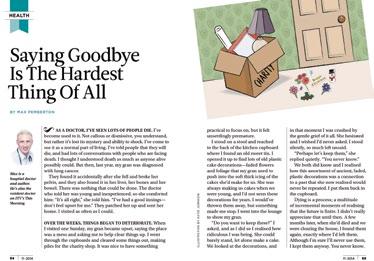
I often wonder how we amassed so much stuff, after starting out with very little. I originally kept things in case my family needed them, but my children were more prosperous than we’d ever been by the time they set up their own homes.
My not-too-ancient baking equipment and cake decorations are still in good use, and will no doubt be kept until I’m gone. But what will happen in the big clear out? Will the memories of magical Christmases and birthday creations be precious enough to keep them, or will they be consigned to the bin? Maybe my grandchildren will want them—as Max and his gran said, “You never know.”
H Woodcock, Fife
bonkers for conkers
I totally sympathise with James Brown’s urge to pocket conkers in “Reasons to be Cheerful”.
I was on one of my regular fivemile runs recently when I spied a number of shiny conkers beneath a tree. I couldn’t resist collecting two handfuls to display on my kitchen window sill and, having no pockets
in my shorts, I continued my run home with a smile on my face.
Then again, I’m only a youthful 73-year-old lad!
Manny aspinall, Manchester
m ischievous memories
Having been brought up in the same part of Leeds as James Brown —although admittedly a couple of
01•2015 | 7
decades earlier—I share many of his memories of conker fights.
Mischievous Night (a true Leeds Loiner will generally pronounce the word “miss-chee-vus” with the accent on the second syllable), celebrated by some and dreaded by others each November 4, is indeed a very Yorkshire affair. I was always told that the tradition harked back to the claim that plans for the Gunpowder Plot were finalised on that night in 1605.
How this justified the playing of pranks on unpopular neighbours, I never understood. The pleasures of Bonfire Night—only 24 hours away —were quite enough for me!
Maggie cobbett, Yorkshire
keeping colds at bay
Thanks for your helpful feature “15 Easy Ways To Beat A Cold”. I started a teaching job two years ago and have lost count of the number of colds and sickness bugs I’ve had already. I was beginning to think I was allergic to children!
I realise now it takes a few years to build up any sort of immunity to them, but knowing ways to combat common illnesses in the meantime is going to be very useful indeed.
suzanne RosWell, Great Yarmouth
instinctive kindness
Chris Hadfield is quite right in “If I Ruled The World” when he suggests you should make your first reaction one of kindness when coming into contact with a stranger.
Since childhood, a wariness of who to trust has been instilled in many of us, and in some cases with good reason. It’s only with opening up and getting to know a person that we gain the opportunity to see their personalities surface and make a friend of them. A failure to change our ideas could result in missing out on many of the good things in life.
gloRia Wilding, Merseyside
the travel bug
“She Gave Me the World”, about Mary Morris’s love of travelling, was an inspiring feature. Motivated by her adventures with her mother, Mary continues to travel. Some people may not understand why she’s planning yet another trip— they probably look at her strangely, wondering why she would want to go away again, especially to a place they’ve never heard of.
However, hitting the road is very important to the Marys of this world. I wish I had her get up and go.
Jolene coopeR, London
8 | 01•2015
We Want to HeaR FROM YOU! send letters to readersletters@readersdigest.co.uk Please include your full name, address, email and daytime phone number. We may edit letters and use them in all print and electronic media.




























see the world turn the page 11
Photo: © Getty Ima G es/Fl I ckr r F

12

What looks like a cluster of falling stars are in reality hundreds of fireflies gathered in a riverbed in hiroshima, Japan. these little insects produce their light through a chemical reaction in their cells, which they can switch on or off as they so please. this is particularly helpful in attracting a mate, but unfortunately draws the attention of predators as well. a big danger also comes from within their own family: a related firefly species imitates the salacious signals sent by females looking for a mate, drawing the love-hungry males into a deadly trap.
… differently
Photo: © Getty Ima G es/Photo r esearchers
rm
James Brown describes the luxury of waking up in a warm bed—and without a dog for a pillow
Finding Shelter From The Storm

James, founder of Loaded magazine, now edits Sabotage Times—an online magazine with the motto: “We can’t concentrate, why should you?”
It’s a s I mple suggest I on, but this month’s reason to be cheerful is bed—and the opportunity to stay in it, warm and safe.
I’ve just finished reading Matterhorn, a superbly engrossing novel set on a fire-support base in the mountains during the Vietnam War. Its opening pages are a masterclass in discomfort—while reading it, I’d never been so glad to be able to just lie in bed when I wake up. From the soaking kit in which the characters live and sleep, to the mud and decimated tree splinters that cling to the hill, the men of Matterhorn are submerged in a physical hell.
Their bodies are struggling with leeches and “jungle rot”, their food and drink doesn’t arrive, and on top of this there are people trying to kill them simply for being there. I don’t just mean their enemy, the North Vietnamese Army, but also their own insanely ambitious and detached commander. If you’ve read and enjoyed The Naked and the Dead by Norman Mailer or Dispatches by Michael Herr, then Matterhorn sits somewhere in between.
With so many tragic First World War anniversaries upon us, there are of course more familiar historical examples
| 01•2015 14
to be cheerful
reasons

of men and women pushed beyond their limits. But there’s a great terror and physical despair to the characters in Matterhorn that brought home what a luxury it is to lie in bed. As a result, I regularly found myself thinking about the worst conditions
I’ve slept in—and most have been out of choice.
the ma I n reasons I’ve slept somewhere other than a bed have been holidays and alcohol. As a 20-year-old, I once slept on a beach
01•2015 | 15
Illustrat I on by st even van H asten
for a week on the Mediterranean island of Elba, but I wasn’t alone and it was an amazing place to wake up in. At the start of that holiday, my girlfriend and I had slept under a small catamaran on a packed beach in Rimini, Italy. There was a moment when a gang of lads on a night out unnerved us by sitting on the boat, but it was nicer than a story comedian Hattie Hayridge tells about staying in Rimini in her autobiography. She and her boyfriend fell asleep on what they thought was a natural pillow in the sand, only to wake in the daylight and discover it was a dead Alsatian.
summer’s morning in Piccadilly Gardens, Manchester, after a party at the Haçienda springs to mind— but others were less appealing. There’s nothing glamorous about being a crumpled footnote in a doorway because you’re incapable of saying no to the next drink.
I’ve long since made sure I spend as much as I can on getting the nicest sheets and bedding available
I have a number of memories of sleeping on musical equipment when I followed bands around as a young writer. Getting the wheel hub in the van for a pillow was utter luxury. I’ve slept on floors, pub benches and church doorways, sometimes just to let the alcohol soak away. When you have an issue with alcohol, people don’t see you at the end of the night.
Some of these incidents occurred because I was having too good a time and had emerged into the world from a club in a different city with no public transport home. A lovely
t he worst n I ght I ever had was in a grimy old railway goods truck with no roof or floor, just outside Sunderland. I had to trudge drunkenly to it from the side of the A1(M) —where I’d failed to get a lift—across a freshly ploughed field. There was a fierce storm raging, my clothes were soaked through and I lay shivering under a bit of plastic fertiliser bag. At this point I was the British Society of Magazine Editors’ Editor of the Year, but despite this such conditions weren’t unusual.
I ponder these things sometimes when I can’t sleep or I’m worried about something. I think about how much better it feels just to be dry, clean, warm, safe, sober. I’m lucky enough to have found someone I like waking up with every day, and the baby that joins us every morning and pokes our faces until we’re awake
Reasons to be chee R ful | 01•2015 16
can only be described as a gift from a higher power—nature itself.
Having slept on enough wood, tile, earth and van floors for a lifetime, I’ve long since made sure I spend as much as I can on getting the nicest sheets and bedding available. So much so that it really is a joy just to lie there and exist, stay in the moment and be glad that the next
time I move I won’t feel a sodden sleeping bag or a fall of water onto my legs.
There are enough people in the world who start the day in extreme difficulties of all sorts to make me thankful for the simplicity of my bed. In fact, I’ve got 15 minutes before I have to think about going to work, so I’m getting back into it.
budding authors, take a bow!
This tale of criminal intrigue was one of thousands submitted to last year’s 100-Word-Story Competition. Turn to p70 for details of how to enter this year’s competition.
what really happened?
the cold-blooded assassin had finished his last job in a remote country in south america, deposing a certain cruel minister in a corrupt political dictatorship. An eye for an eye, he thought.
the assassin never knew who his paymaster was, but he always felt better assassinating a vicious politician responsible for many innocent civilian deaths themselves. It wasn’t always a bullet from a high-powered rifle; he often made them look like accidents. escape was just as important in his profession.
one last job, he thought, then he’d retire.
Details came in for his next assignment: Paris, the ritz. Stuart Collinson, Edinburgh

Stuart says: “I prefer to read short stories rather than long novels. I usually get an idea for a fictional tale from something that’s happened in the news recently or from history. I like the reader’s Digest competition because it’s a fun challenge trying to fit a story into exactly 100 words.”
Stuart will receive a cheque for £50.
01•2015 | 17 Reade R ’s d igest























































Films
Movie of the Month
Reese Witherspoon gets in touch with nature in Wild by tom browne and laura dean-osgood
■ biopic: wild Reese Witherspoon gives an Oscar-worthy performance in this Nick Hornby-penned adaptation of Cheryl Strayed’s celebrated memoir. It details Strayed’s decision to hike more than 1,000 miles of the Pacific Crest Trail in California, Oregon and Washington—despite no experience —as a way of tackling her demons following the death of her mother, her divorce and her subsequent decline into drug addiction and promiscuity. This “journey of discovery” narrative has been seen before in films such as Into the Wild, but director Jean-Marc Vallée keeps the action moving at a brisk pace (unlike the main protagonist), and there are plenty of fine supporting performances.
■ drama a most violent year Abel Morales (Oscar Isaac) is an aspiring businessman in 1980s New York, trying to expand his fuel business in the face of threats and corruption. This gripping film recalls the hard-boiled dramas of the Seventies—Isaac’s portrayal of Abel, a decent man drawn into a shady world, is very similar to Al Pacino’s Michael Corleone in the Godfather films. Jessica Chastain also stands out as Abel’s resourceful wife.



■ romance: suite Française Jewish author Irène Némirovsky only finished two of her planned sequence of five novels about the Second World War before being sent to Auschwitz in 1942, where she died. This big-screen adaptation, starring Michelle Williams, Kristin Scott Thomas and Matthias Schoenaerts, inevitably fails to capture the power of the source material—lots has been lost in translation—but it’s still a visually striking and well-acted movie.
01•2015 | 19 entertainment © 20TH CENTURY FOX / © I CON F I lm D I s TRI b UTION / © ENTERTAIN m ENT ONE

■ war: testament oF youth There have been plenty of dramas marking the centenary of the First World War, but this adaptation of Vera Brittan’s memoir is the best so far. Swedish actress Alicia Vikander is mesmerizing as the girl who turns down a place in Oxford in order to serve as a nurse on the Western Front, an experience—along with her personal losses—that led her to become one of the 20th century’s most celebrated pacifists.
■ comedy: birdman Michael Keaton plays a fading movie star determined to prove himself as a serious artist—by writing a Broadway show. The events leading up to the opening night prove surreal and darkly comic, and are bolstered by a cast of indie favourites (Emma Stone, Ed Norton) and a fantastic soundtrack. A festival favourite, it’s destined for award success.

DVD of the month
■ a walk among the tombstones Liam Neeson’s back doing what he does best: seeking revenge.
On Your Radar Katherine Thomson, teacher
Watching: wentworth Prison (channel 5) This is my guilty pleasure—it’s compulsive viewing and I have to watch it!
Reading: murder most Fab by Julian clary Written with plenty of black humour, you sympathise with the main character even when you really shouldn’t.


Online: mysterycasefiles. com These online games can be complicated and annoying, but when you finally solve the mystery it’s well worth it.
listening: the graham norton show (radio 2) This show makes my Saturday morning. Graham is always a pleasure to listen to.
Fancy appearing in this section? Send your current cultural favourites, along with short descriptions, to readersletters@readersdigest.co.uk
| 01•2015 20 ENTERTAIN m ENT
© l ION sg ATE / © 20 TH CENTURY FOX
Torn apart: Kit Harrison and Alicia Vikander
by mandi goodier Album of the Month
Panda bear meets the grim reaPer (Pbvsgr)
Person Pitch, the fourth album released by Noah Lennox (aka Panda Bear), was named by influential music blog Pitchfork as their album of the year in 2007. Two albums later, can he do it again? The answer is a resounding yes.

PBVSGR is like being taken through the depths of space as depicted in a 1960s psychedelic cartoon, with only a folk choir for company. This might sound chaotic, but the album stays completely in control of itself, its occasional repetitiveness forgiven as one becomes absorbed in kitsch electronic noises held together by the beautiful harmony of the vocals. The overall effect is a soundscape of which Brian Eno and Wayne Coyne (The Flaming Lips) would be jealous.
Key tracks: “Noah”, “Come to Your Senses”, “Tropic of Cancer”
Like this? You may also like: Brian Eno, The Flaming Lips, Animal Collective
overlooked record from the past an electric storm by white noise
burns’ night, Jan 25 Celebrate the poet’s birthday. Music

In 1969, one year before Kraftwerk’s seminal debut, White Noise unleashed the more obscure An Electric Storm. Formed by members of the BBC Radiophonic Workshop (the sound effects department), the idea behind White Noise is immediately clear— electronic effects and samples used to melodic, dramatic and uncomfortable ends. The vocals, not unlike The Velvet Underground, are naive, but they direct the strange noises into accessible (if not sinister) pop songs. The result is astounding.
On Our Radar
rps international images for science, dec 20–Feb 7
Amazing photos at Barnsley Civic Centre. london short Film Festival, Jan 9–18
Fleeting flicks shown across the city.
01•2015 | 21 r eader’s d igest
© REX/R AY sTE v EN s ON listen to these albums at readersdigest.co.uK/listen
actor Ashley Jensen , 45, found fame alongside ricky Gervais in BBc’s Extras and appears in sky 1’s Agatha Raisin and the Quiche of Death this christmas
“IAshleyRemember” Jensen
…getting covered in dog poo. I was walking home in Glasgow when I was about four and got scared by a fight between some Celtic and Rangers fans. I ran, tripped, rolled down a big hill and was coated from head to toe—in my mind, anyway—in canine faeces. There was a lot more sectarian fighting in Scotland in the early 1970s, with the Catholic and Protestant rivalry all mixed up with football. But it wasn’t a big issue in our house, so I didn’t know a lot about it. Kids would ask, “What’s your favourite colour, green or blue?” and I’d answer “Erm, green?” and they’d shout “WRONG! BLUE!”

Or vice versa, depending on who was asking.
…moving to the country just before my fifth birthday. My parents had divorced when I was tiny and my mum Margaret, a teaching assistant, and I lived with my grandparents. Mum wanted me to have a rural upbringing, so we all relocated from Glasgow to Annan, south-west Scotland. I’ve done the same thing with my five-year-old Frankie, taking him to live in Bath rather than London, so he can faff about with babbling brooks, play on rope swings and look at conkers.
entertainment | 01•2015 22
photos courtesy of ashley jensen / © W enn l td/ a lamy

…a recurring childhood dream about l aurel and hardy. It involved me sitting watching them in a theatre and to my right was a giant meatball. Years later, I was working with Ricky Gervais on Extras and he was saying how our characters Maggie and Andy should have a Laurel and Hardy-type relationship. I thought, Ah, maybe my dream was a little look
into the future! What the giant meatball pertained to, I’m not sure.
…loving the brownies. We used to skip round wooden toadstools singing, and we’d collect bottle tops for the blind. For years, I thought it was because they were reflective. I got an armful of badges. I think I’ve always been a little competitive.
01•2015 | 23
Ashley as a “small chunky toddler”
With her mum on a holiday in France

…pretending to be t erry w ogan. I was a theatrical child and would make radio shows on a cassette recorder. I’d also do Miss Piggy and Frank Spencer impersonations. Frank Spencer made me want to be an actor. I loved his character, his naivety, his physical comedy.
At secondary school I was very good at athletics, but that tailed off as I got older and fell in with some arty farty kids. I’d make my school uniform more flamboyant by teaming a long Victorian skirt with a Peruvian-style hat and bits of lace in my hair. The teachers
would look out the window and say, “Oooh, here she comes, Dame Flora Robson.”
…there was no drama department at school, but I loved the idea of acting. So aged 16, I joined an amateur dramatic company with a load of old people—who must have been at least 40. Then my mum heard about the National Youth Theatre down in London, I got a grant from the Prince’s Trust to go (it was expensive for a working-class Scottish girl) and I appeared in a play called The Dream Ticket. I went home and said, “Acting is definitely, definitely what I want to do for a living,” and my mum was like “OK, right [deep breath].” But she was incredibly supportive and it had been very brave to let her child get involved in a world she knew nothing about.
…feeling cold at college in e dinburgh. I was in a big flat with no heating and my friend Alison Banks and I had to use hairdryers to warm our beds. I did three years at Queen Margaret Drama School, which later became a university. I think a monkey could have done the course. But I was that monkey and I absolutely loved it, hanging out with people like me who wanted to act, tell stories and arse about playing at fame.
24 | 01•2015
…doing a real acting apprenticeship. My first job after drama school was The Crucible at the Citizens Theatre, Glasgow. I played Betty Parris, a child who lies comatose in a bed for the first 40 minutes. I was under no illusions why I was there—I cost less than a child and a chaperone. I also played Oor Wullie in a cheapskate liveaction version of the cartoon strip. The bucket I had to sit on was a 2D prop that gave me welp and we toured all these little theatres where rain would come through the ceiling.
But, weirdly, I always felt successful. I just wanted to entertain people, and I was earning a bit of money. But I didn’t have an alternative career or rich family to fall back on, so I would
never say no to things. I’m still a bit like that. I’d have done some terrible parts if my husband Terry [Beesley, a fellow actor] hadn’t stopped me.
…a barbaric courtship. I met Terry in 1999 when I was Regan and he was the Duke of Cornwall in King Lear in London. We fell in love plucking the Earl of Gloucester’s eyes out, although they were only lychees.
My career was going quite well and I was doing a fair amount of TV, such as BBC oil-rig drama Roughnecks. But after we got together, Terry and I would buy neglected flats, do them up and sell them to earn more money. I knew he was the man I wanted to marry because he could take a toilet out and put one in, and he was an actor. It was a really happy time—hands-on work, but we’d have music playing and sit in the rubble at the end of the night, drinking beer.

…my first day on Extras with s amuel l jackson. By 2005 I’d done a few more TV roles, such as Babs in BBC1’s Clocking Off, but this was my big break and here I was doing my first scene with a major Hollywood actor. I just thought, OK, I can be intimidated by
Reade R ’s d igest 01•2015 | 25
Meeting her husband in 1999 in King Lear
this or I can just jump in with both feet and go, “We’re all just human beings, even though that’s Samuel L Jackson and that’s Ricky Gervais.” Then Ricky and I started arseing about, dressed as policemen, and I was fine.
…a photograph my husband took of me, just before going to the emmys. I’d been nominated for Outstanding Supporting Actress for Extras and I was standing there with someone doing my dress, someone doing my nails and a man waiting with
a £500,000 necklace for me to borrow. That was a world I’d never anticipated being part of, but I was able to see it for what it was and enjoy it.
…feeling sad in los a ngeles. I moved to play Christina McKinney in the US series Ugly Betty in 2006. Terry couldn’t join me for a while, so I was alone, British, self-deprecating and relatively quiet among all these loud, ambitious Americans with five-year plans. It was difficult.
My flat had two resident cats that the landlady expected me to take care of. It stank of p*** and s***. I was too scared to drive in LA, so I ended up getting taken to the set at 6am in a minibus with the guys who cleaned the toilets. I’d be sitting freezing in this wee cold trailer before anyone had arrived, thinking, This is Hollywood. I’ve made it. Living the dream. LIVING THE DREAM!

My agent sent me some cupcakes for my birthday and I was almost in tears. Why couldn’t it just have been wine?
…weeping while doing a voiceover for c hannel
4’s Embarrassing b odi E s in 2009. People always remember the amusing penises, but that show has so many other stories about people recovering from cancer or some facial deformity. I was pregnant and hormonal,
I remember
© re X/ s te W art c ook
Ashley and Terry on the red carpet at the Emmy Awards
so I was crying all over the place.
.…lying on the ground in a burning room, with flames inches from my face. I was filming Agatha Raisin and the Quiche of Death and we were doing a house-fire scene. I turned up and thought, Where’s the stand-in in the blonde wig, dressed as me? Oh, there isn’t one . Next thing I knew, I was on the floor with the stuntman saying, “You can tell people you do your own stunts now.”
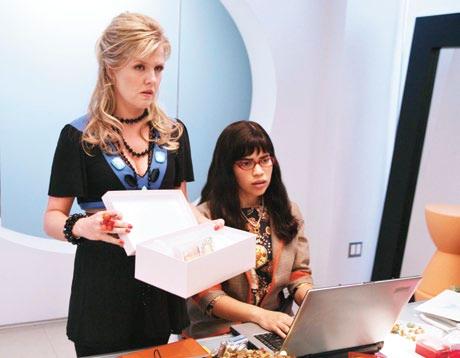
“Living the dream” in US show
Ugly Betty
…learning to live in the now. In America particularly, people are always aspiring for the next thing. Even in Britain we’re constantly Tweeting or on our phones. But Terry and I have got a little house in Italy now and
he’s great at admiring the sunset and appreciating the moment.
Also, my child makes me want to be as kind and calm a person as I can, look at things with new eyes all the time and say, “Oh, my God, a conker. That’s amazing.”
As told to Simon Hemelryk
fITTING THE BILL
a new tool by youGov profiles is revealing the tastes of the nation. just type in an interest to the profiler for interesting results:
A Beatles fan’s favourite food is gooseberry tart. people who shop at lidl listen to manfred mann and tina turner. Peppa Pig fans are most likely to have a fish as a pet. arsenal fans like to read erotica.
Fans of both Reader’s Digest and Downton Abbey share a niche interest of “writing letters to the editor”.
Reade R ’s d igest 01•2015 | 27
© m oviestore collection l td/a lamy
Agatha Raisin and the Quiche of Death airs on Sky 1 on December 26
Caption
COMPETITION PICTURE
Jazz up your January by winning a swanky West End theatre break, courtesy of our Over 50s Life Cover partner, Royal London.
e have teamed up with our Over 50s Life Cover partner, Royal London to launch this month’s caption competition.
Royal London will be treating the lucky winner to a theatre break for two in London. is exclusive prize includes:
Royal London Over 50s Life Cover is designed for those people who require cover for the whole of their life. Guided by old fashioned values, the policy is designed to provide a cash sum to help cover your funeral costs or to leave behind as a gift for your loved ones when you die. e policy only pays out on death, and there is no cash value at any time.
❖ Two tickets to a West End show of your choice.
❖ Pre-theatre dinner for two.
❖ Royal London will also cover the cost of your return travel and for one night’s accommodation in the capital.
For your chance to win this fantastic prize, send your caption for the picture to marketing@readersdigest.co.uk, or post to - Reader’s Digest, PO Box 7853, Ringwood, BH24 9HF. Terms and conditions apply - for full details please visit, www.readersdigest.co.uk/terms-and-conditions. The competition opens on 26th Dec 2014 and closes 27th Jan 2015.
Judging will be carried out by the Reader’s Digest Editorial Team with the five best entries being published in the March edition of the magazine. The overall winner will be chosen from the top five by our Editor Tom Browne. GOOD LUCK!
ADVERTISEMENT FEATURE






If you would like to nd out more about Over 50s Life Cover from Royal London simply call 0800 022 4994 and quote PTN026 or visit www.royallondon.com/readersdigest.co.uk “I’ll have what they’re having Can you beat our caption? Reader’s Digest is a trading name of Vivat Finance Ltd, which is an Introducer Appointed Representative of The Royal London Mutual Insurance Society Limited. Vivat Finance Ltd is not part of The Royal London Mutual Insurance Society Limited. The Royal London Mutual Insurance Society Limited is authorised by the Prudential Regulation Authority and regulated by the Financial Conduct Authority and the Prudential Regulation Authority. The firm is on the Financial Services Register, registration number 11672. Registered in England and Wales number 99064. Registered o ce: 55 Gracechurch Street, London, EC3V 0RL.
Terrible Ideas That Worked!
Once in a while, a dim-witted suggestion is proposed and, against all the odds, it succeeds. Here are a few such tales
by andy simmons
A “Relations” Strike
As long as anyone could remember, the lone road that linked the small Colombian village of Barbacaos to the rest of the world had been awful. So bad that it took half a day to make the 35-mile trek to the next town. Demands that the road be fixed went unheeded. The last straw came when a young woman and her unborn child died in an ambulance after it got stuck on the road and couldn’t reach a hospital in time.
Women hit the streets in June 2013 in a mass protest dubbed “the cross legs movement.” In short, there would be no hanky panky until the road was repaired. Even the town’s mayor fell victim: His wife took to sleeping in another room.

It Worked!
the strike was called off the following october as bulldozers and machinery began repairs. the new road is expected to cut travel time to the nearest town by six hours. Source: pri.org
| 01•2015 30
Illustrat I ons by n I shant choks I
entertainment
Skirting the Job
When a heat wave struck north of Stockholm in the summer of 2013, male train workers began wearing shorts on the job. But management pointed out that shorts fell foul of the railway’s dress code. So the men switched to wearing skirts.
It Worked!
If men wear skirts, that’s ok because women wear skirts, said a spokesman. “to tell them to do otherwise would be discrimination,” he explained. a change to the dress code to allow shorts quickly followed the action. the company claims that male workers in skirts had nothing to do with it.
Return to Sender

Dogs are wonderful creatures with one major flaw—they refuse to pick up after themselves. This is especially challenging in Brunete, Spain, where dog owners don’t pick up after the dogs either. But the advertising firm McCann concocted the ultimate nudge—send the mess back to the owners. The idea, which it dreamed up without being asked, works this way: a volunteer chats up a nonscooping owner and finds out the canine’s name. After the dog walker and pooch leave, the volunteer gets the owner’s name and address by matching the dog’s name and breed in a database accessible on his mobile phone. He then scoops up the mess, places it in a package marked “Lost Property,” and sends it to the owner.
It Worked!
During the campaign, 147 deliveries were made, resulting in a 70 per cent decline in the amount of dog droppings littering the streets.

01•2015 | 31
Pot-Luck Pigs
With marijuana legal in the state of Washington, pot growers in the US pondered how to profit from the plant’s leftover stems and roots. Local pig farmers, meanwhile, were coping with pricey feed that cut into their profits. One farmer proposed a solution: combine the cheaper marijuana remnants with their pig feed.

It Worked!
the surplus pot lowered pig farmer susannah
Gross’s feed costs and produced another benefit: the munchies. Pigs that guzzled the pot gained an extra 20 to 30 pounds compared with hogs that didn’t. Gross told reuters, “they were eating more, as you can imagine.”
Barking Out Baddies
After two suspected car thieves in New Haven, Connecticut, refused to come out of the house they were holed up in, police announced that they would send in the hounds. The only trouble? A serious lack of police dogs on the scene. So a couple of cops snuck up to the front door and began barking.
It Worked! the petrified intruders ran out and surrendered.

Flushing Trouble Down the Drain
A severe drought and poor maintenance had messed up the sewers of Bulawayo, Zimbabwe. And because of insufficient water pressure, the pipes kept clogging, causing some to burst. So without a huge plunger, what’s a city to do? Simple, said the town council. Twice a week, citizens will simultaneously flush their toilets in order to produce enough water pressure in the sewer system to dislodge clogs.
It Worked!
one resident told the associated Press, “so far, the flushing of the toilets has been a success.”

| 01•2015 32 TE rr IBLE IDEAS THAT WO rk ED !
Music to Flee From
Either Portland, Oregon, isn’t a happening place or its railway station is, because young men have taken to hanging out in it. Numerous attempts to disperse the crowds have failed. Now the authorities have delved into their own youths for a solution by asking themselves, What would drive me away? The answer: opera. And classical music. Blared over the station’s speakers during a pilot programme.
It Worked!

there was a drop in 18- to 25-year-olds loitering once the music began. In one incident, a young man stormed out of the station just as bizet’s carmen proclaimed her love for he who does not love her. the british royal navy has also taken to blaring britney spears at somali pirates. “these guys can’t stand Western music,” an officer told metro.co.uk. “as soon as they get a blast of britney, they move on as fast as they can. It’s so effective that the ship’s guards rarely need to fire guns.”

It Worked!
Mountain Mirrors
Until recently, winter in rjukan, Norway, was a depressing time. The town is situated in a deep valley and goes up to six months a year without sunshine. To lighten the mood, so to speak, the town acted on an idea that had been bouncing around for a century: construct huge mirrors on a nearby mountainside to reflect the sun’s rays down into the town square.
thanks to computer-driven motors that allow three massive mirrors to follow the sun’s path, the autumn sun shone on rjukan’s town square for the first time ever in 2013. to celebrate, some rjukans sipped cocktails while tanning on lounge chairs; others played volleyball on a makeshift beach. “the idea was a little crazy, but madness is our middle name,” a local project co-ordinator told agence FrancePresse. “after basking in the sun, people are beaming themselves.” the mirrors will light up the town square throughout this winter too.
01•2015 | 33 Reade R ’s d igest
LOOK AWAY NOW!
Meet the man whose skills in gory make-up and prosthetics have earned him worldwide renown
By Christopher Middleton

entertain M ent 34


e can make you older or younger. He can give you an extra eye or gigantic nose, and he can inflict any number of unsightly afflictions on you, from an open wound to a plague of boils. Yes, not for nothing is Neill Gorton known as the prince of prosthetics: the man to whom TV and film producers automatically turn when only the most grotesque will do.
Remember the bodies and blood on the beaches in Saving Private Ryan ?
All came courtesy of Gorton. He’s worked with everyone from Andrew Lloyd Webber to Stephen Spielberg, from Catherine Tate to Lady Gaga. He’s done prosthetic disguises for Paul Whitehouse and Ant and Dec. More impressively, he also created
the tiger that mauled Russell Crowe in Gladiator .
This is the man who can create anything from a slavering-jawed werewolf in the TV series Being Human, to a Doctor Who (Matt Smith in this case) transformed from young timelord to ancient, wrinkly old gentleman. Doctor
look away now! | 01•2015 36
i M ages courtesy of g orton s tudio
Neill and his interpretation of Count Orlok from Nosferatu
Who is, in a way, where it began for Gorton—as a young boy marvelling at the creatures encountered by the Tardis travellers.
“I’d always loved the programme when I was little,” says Neill. “So when I was asked to work on the series after it came back and moved to Cardiff a decade or so ago, I didn’t hesitate. At the time, there was a lot of anxiety about the relaunch, but it’s gone from strength to strength.”
This is due in no small part to the sort of monsters emerging from the Gorton workshop—not least the race of extra-terrestrials known as the Slitheen. On the surface, they wear the clothes and faces of human beings, but underneath they are a breed of bug-eyed mutants intent on destroying Earth.
over the years, Neill’s reputation has spread across the globe, with the result that students come from all countries to acquire the art of applying monstrous foam and silicone to the human face.
Alongside his teaching courses, he’s built up a thriving prosthetics and special-effects
company called Millennium FX— a firm that has numerous Bafta and Royal Television Society awards in its trophy cabinet.
Neill began his first work placement at the age of 15, and by 18 he was working full-time in Los Angeles. He was then recommended to seasoned sci-fi director Gerry Anderson, worked on the big-budget TV series Space Precinct, and became head of department at the age of 23. When he set up Millennium FX, he entered the prosthetics premier league.
Being top of the pile makes for long hours—many days of preparation and a readiness to spring into action at short notice. But that hasn’t stopped 14 ambitious special effects and prosthetics artists gathering at Nantgarw College, ten miles north of
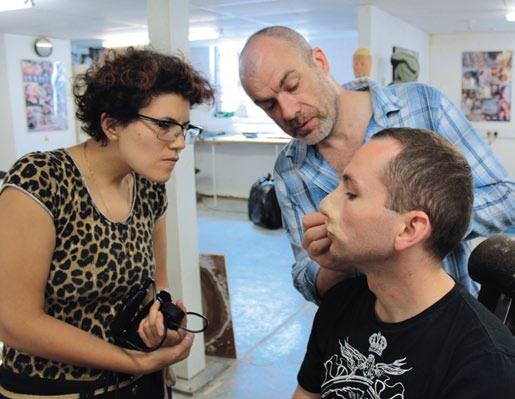
r eader’s d igest 01•2015 | 37
Neill teaching the fine art of prosthetics
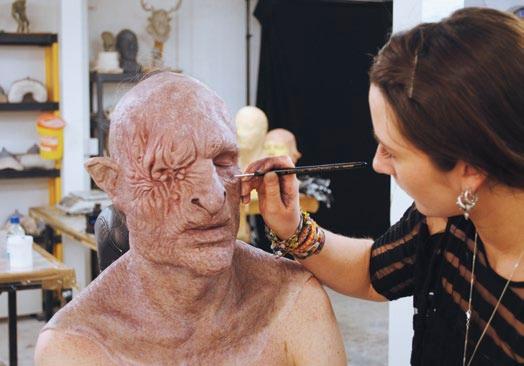
Cardiff, and paying £250 for a course that will give them access to some of the Gorton secrets.
The weekend course is a bit of a taster—there are longer and more intensive Gorton courses that serve to indicate which students might go on to have a full-time career in the art.
“On those courses, the idea is that people build up a professional portfolio of work that will get them a job,” says Neill. “With the shorter courses, it’s more about people coming along to improve their skills and see if this might be for them.
Students putting Neill’s techniques to good use
related to prosthetics. There are some courses where you spend two weeks learning how to powder the nose of a weatherman.”
the first tip
he passes on to today’s students is that there’s a big difference between a latex and a silicone prosthetic.
“A silicone headpiece can weigh a couple of kilos, which is a lot to carry around,” he says. “Not only that, but a long silicone nose will start to droop after a while.”
“Expectations are much higher these days, because there are so many special effects around”
“But one thing I promise students is that the work they do will all be
The first chapter of the gospel according to Gorton, then, is (a) to choose the right material and (b) to carry out all kinds of camouflage, to ensure that high-definition movie cameras don’t pick up the point where the artificial face ends and the real one begins. This explains the arsenal of glues, powders, sprays and flesh-coloured make-up pots he carries around. Not to mention the brushes that do everything from providing all-over
look away now! | 01•2015 38
skin tones to adding tiny black spots that look like male chin stubble.
“When you’re on set, the clock is ticking,” he warns. “One minute you’re sitting doing nothing, the next you’re being given an old coffee cup and a straw, and told to create a blood-pumping ring.”
This is something that happened to Neill on the set of a series called Hex. Though it sounds complicated, that, he says, is the point.
“Everything you’re asked to create is difficult to some degree, because you’re having to make things that don’t exist. On top of which, expectations are much higher these days, because there are so many special effects around.”
Not that Gorton works alone. Here to help the course run smoothly is his studio manager Danny Marie Elias, who has herself built up a long list of prosthetic credits on productions from Sherlock Holmes to Wizards Vs Aliens to the forthcoming Victor Frankenstein.
“What I like about this job is that no day is the same and no two characters are the same,” she says. “One day I’m working on Casualty, the next I’m on a film set somewhere else. And believe it or not, Wales
is a great place to be if you’re in this business. People round here are shocked and surprised when I tell them what my work is, but there are lots of opportunities right now here in Wales!”
There’s no question that the business has moved on, says Neill. “Twenty years ago, people were amazed by the dinosaurs on screen in Jurassic Park,” he smiles. “Today, though, kids can call up the same kind of special effects on their home

r eader’s d igest 01•2015 | 39
An alien girl done as part of a live demonstration


computers. Technology never stops in this business.”
Geographically, too, there’s been a shift westwards, away from Pinewood and Shepperton Studios.
“There are lots of prosthetics and special-effects firms in Cardiff now,” says Neill. “Along with Doctor Who, it’s also where Da Vinci’s Demons and Atlantis are made.”
No accident, then, that this course is being held close to Cardiff, although professionals have to be prepared to travel where the work is.
“I always make clear to students that this is a freelance industry,” stresses Neill. “You’ve got to go out and get hired on the strength of your own reputation. And you have to
realise that you’re only employed for the duration of a project. On top of this, if there’s a shortage of UK film and TV projects, you’ll have to look abroad.”
Indeed, many of Neill’s former trainees are now gainfully employed all over the world—as some of this weekend’s course participants soon hope to be.
“My ambition is to create monsters with a view to terrifying people,” says Carl Gabriel, who’s attended Gorton’s courses in the past. “One thing Neill has taught me is that, however frightening your creations are, you need to have good contacts in this business. Which is why I stay in touch on the internet with
| 01•2015 40 look away now!
A witch created while teaching the Prosthetics Boot Camp; (right) one of Neill’s out-of-this-world creations
everyone I’ve met on this course and previous courses.”
The same applies to 39-year-old Mark Danby, who’s flown to Cardiff from Newcastle in a bid to sharpen up his skills.
“I’ve done quite a few prosthetics jobs here and there, but at this stage I’m looking to get something fulltime,” he says. And having applied a false chin and eyebrows to a volunteer model this morning, he’s aiming to go one step further this afternoon, with a foamrubber plague of spots and boils.
“Some models go home wearing their prosthetics. They drive off with chins and noses that aren’t their own”
by the end of the session , the room is full of people who started the day looking normal, but have acquired an unnerving collection of facial peculiarities. What’s more, some of them don’t intend to take them off for a while.
“Quite a few models go home wearing their prosthetics,” smiles the course tutor. “They choose to drive off with chins and noses that aren’t their own.”
Meanwhile, other students have chosen to graft on a variety of outsized ears, swollen cheeks, black eyes, veiny hands and pointy witches’ noses on their unwitting models.
You can only imagine the cries of alarm and consternation they will cause when they step though the front door. But that, of course, is what Neill Gorton is all about.
For more information about neill gorton’s courses, visit gortonstudio.co.uk
please sign here…
some government petitions—everything from healthcare training to animal welfare—receive hundreds of thousands of votes. the following ones failed to rouse as much interest.
Petition: Hoodies should be banned (89 votes)
Petition: abolition of money (60 votes)
Petition: Ban all fireworks that have bangs (46 votes)
Petition: introduce a 99p coin (15 votes)
Petition: stop emigration please (11 votes)
soUrCe: UKranKandFile.wordpress.CoM
01•2015 | 41 r eader’s d igest
FOR MORE, GO TO readersdigest.Co.UK/entertainMent
From leading experts, news of advances towards beating this disabling disease
Mystery the Solving of
You’re Young, healthY, with endless possibilities ahead—love, career, family. And then…something odd happens. Your body refuses to do what it’s always done. Maybe your left leg gives M S
by AnitA bA rtholomew
| 01•2015 42
Illustrat I on by john r I tter
he A lth

way suddenly. Or your right arm tingles and becomes weak. Or perhaps you can’t see out of one eye. What on earth could be wrong?
Your doctor orders an MRI image of your brain and spinal cord, finds telltale scars known as lesions—damage to your central nervous system—and delivers the diagnosis. You have multiple sclerosis (MS), an incurable disease that might one day disable you.
What happens to all your plans for the future now?
W hen your immune S y ST em is doing its job properly, it defends you against viruses, bacteria and other microscopic invaders. But if you have MS, some of the immune system’s warrior cells get confused and decide that your neurons (brain and spinal cord cells) are enemy invaders. They throw everything they have at the “enemy”. They strip the protective myelin coating from axons, the neurons’ information conductors. That interrupts the cells’ ability to send signals to the rest of your body. Muscles, thought processes, joints, eyes—all require clear signals in order to function well.
Across Europe, MS afflicts approximately 630,000 people, according to the World Health Organisation. The disease affects about twice as many women as men and typically strikes in the late 20s or early 30s. You’re more likely to get MS if a parent or sibling has it, but “it’s not a genetic disease in the strict sense”, says Professor Reinhard Hohlfeld of the Institute of Clinical Neuroimmunology in
Munich, Germany. Many different genes play roles in the condition, and MS requires some sort of trigger or combination of triggers to set the process in motion.
It’s not always an easy illness to diagnose. “There are no two persons with the same kind of disease presentation and symptoms,” says Dr Marie D’hooghe of the National Centre for Multiple Sclerosis in Melsbroek, Belgium. Depending upon the area of the nervous system affected, initial symptoms could include sudden blindness in one eye; weakness or tingling in a limb; loss of bladder control; balance problems; or difficulty with reasoning and memory. But unlike Alzheimer’s, the disease rarely affects long-term memory, general intelligence or reading comprehension.
The form m S mo ST of T en Take S at the onset is known as Relapsing Remitting (RRMS). Symptoms usually appear without warning, then either completely or almost completely disappear on their own, even if not
| 01•2015 44 solv I ng the M ystery o F M s
treated, in days or weeks. But they leave behind damage.
Most people with RRMS (about 80 per cent) will eventually advance to Secondary Progressive MS (SPMS), although it may take 25 or more years: just a slow, steady decline that could eventually be completely disabling.
Another type, Primary Progressive MS (PPMS), affects about ten per cent of those with MS and usually strikes after 40. Instead of relapses and remissions, symptoms slowly get worse. While RRMS typically affects the brain, most people with PPMS “show

a well-functioning immune system is essential to health. So, the goal of the newer lab-produced monoclonal antibody drugs, much like the goal of our own natural antibodies, is to target more precisely cells that cause disease. Dr Tim Coetzee of the US National Multiple Sclerosis Society dubs monoclonal antibodies “smart bombs” thanks to their ability to “wipe out the immune cells that are bad, but leave the rest”.
The most recently approved monoclonal antibody for MS (currently approved for use as an MS treatment
access to Medications is variable. it’s liMited in soMe eastern european countries
symptoms that reflect significant involvement of the spinal cord”, says Dr Regina Schlaeger, a neurologist and MS researcher with the University Hospital Basel, Switzerland. As a result, those with PPMS often have problems with their legs.
on C e T he ma SS ive inflammaT ion of a relapse has been extinguished with corticosteroids, the first line treatments prescribed to limit further relapses are inteferon drugs or glatiramer acetate (Copaxone).
But these drugs put the brakes on the immune system as a whole. And
in Canada, Europe and Asia), alemtuzumab (Lemtrada), is a repurposed drug, developed in the 1980s to treat a type of leukemia. Clinical trials showed that alemtuzumab reduced both the number of relapses and the extent of brain lesions in early RRMS.
Three new oral drugs—fingolimod (Gilenya), teriflunomide (Aubagio) and dimethyl fumarate (Tecfidera) —are now available. Before their approval, all MS medications had to be injected.
But some may have to wait for the latest treatments. “Availability of medications is very variable worldwide,”
Reade R ’s d igest 01•2015 | | 45
says Professor Alan Thompson of the MS International Federation. He says access is limited in some Eastern European countries.
There are no drugs approved specifically for Secondary and Primary Progressive MS, and those used for RRMS don’t work against progressive
disease, although anecdotal evidence suggests that their use during the RRMS phase may delay or prevent later progression.
Physiotherapy is among the most effective treatments at the progressive stage, says Professor Thompson. Although targeted to the affected areas,
live in the moment
In January 2007, I shovelled away the ice in front of my house. Within a couple of days I couldn’t see out of my right eye. Doctors treated me with cortisone and my eyesight cleared. then about ten months later a large part of my face went numb. again, everything soon returned to normal. but a year later, I lost visual sharpness in my right eye, and it got bigger. I had trouble writing and walking. I went to sibiu County hospital. there I learned I had Ms. In December 2009 a neurologist prescribed betaferon. then four years later, in january 2013, my medication was changed
to another brand of betaferon. It was just a change in supplier, but for some reason, I immediately had problems. I continued with the injections. It took longer than a month to get my disease under control again.
My most recent and most terrifying episode was in january last year. Dizziness, my legs and feet didn’t work; I lost control of my bladder and rectum. It passed in three months but even now both feet are still numb and this affects my balance.
today, I am trying to pay attention to myself. I write my feelings on my blog (greencharme. blogspot.com). I have family, friends, the Ms

Irina-Eliza Penciu, aged 36, Sibiu, Romania
association, music and photography. I also have a terrific job.
I am scared about what will come. but I have sayings that guide me: Carpe diem (live the moment), festina lente (hurry up slowly), dolce far niente (sweet idleness) and cogito ergo sum (I think therefore I am). the hope is tiny, but god is great—he knows what’s best for me.
| 01•2015 46 solv I ng the M ystery o F M s
it’s “not just about focusing on muscle”, he says. “There’s actually evidence of influencing how the brain responds to damage.” Working the body, in other words, might coax the brain into self-repair.
S oon do CT or S may have ye T another “smart bomb” in their arsenal, but with an important difference. The new monoclonal antibody, known only as rHIgM22, is the first that appears capable of rebuilding the neurons’

potentially offering a new treatment for secondary and primary progressive MS.
Women have long reported suffering fewer relapses during pregnancy, prompting UCLA researchers to administer estriol, a hormone that’s abundant during pregnancy, together with glatiramer acetate to nonpregnant women with RRMS. In this recent study, the women taking estriol had 47 per cent fewer relapses than those who got glatiramer acetate and
coMbinations of genes and viruses, and when they occur, can affect Ms
protective myelin coating. That means rHIgM22 might be able to halt or even reverse damage in the progressive phase. It’s currently in clinical trials.
Often, a breakthrough in treatment comes not from a new drug, but from a remedy developed for a different disease, used in a new way.
In one recent study in the The Lancet, statins, originally developed to lower cholesterol, dialled back both nervous system damage and disability in secondary progressive MS. And a March 2014 study in the journal Neurology suggests that cannabinoids —compounds found in the marijuana plant—can help rebuild the protective myelin coating on a neuron’s axons,
placebo, and also scored higher on cognitive tests. Estriol is widely prescribed for menopausal symptoms.
And researchers such as Dr Emmanuelle Waubant, professor of neurology and pediatrics at the University of California at San Francisco MS Centre, are finding out why some people get MS, while others escape it. Dr Waubant found that though exposure to some common viruses appears to increase risk, exposure to others might actually lower it. But that doesn’t tell the full story.
“There are probably interactions between the genes one has, the type of viruses one acquires and what time you acquire those infections,”
01•2015 | | 47 r e A der’s d igest
says Dr Waubant. In other words, it’s not just which genes and viruses combine that appears to increase or decrease risk. When they combine might be just as important to determining your risk of MS. Understanding these complex interactions may help researchers develop strategies for treatment and prevention.
A fighting spirit
I’ve been sufferIng from Ms since I was 24 in 1977. the disease went undetected for years, then I was treated with cortisone and betaferon, but the drugs couldn’t stop the disease and prevent new relapses. In 2005 I was told I had Chronic Progressive Ms, and that my condition would probably get worse. they were right: I’m now in a wheelchair fulltime, but there’s still so much about life that I can enjoy.
I really like going on holiday with my wife Monika. We go to lake Constance on the rhine, where the hotels offer rooms and other facilities for disabled people.
I love watching football on tv and
bu T you C an help T o manage m S your S elf . It tends to be more prevalent in countries where people get less sun exposure, and being deficient in vitamin D (produced in the body in response to sunshine) increases the risk of getting the condition. Dr Marie D’hooghe recommends monitoring vitamin D levels,
sometimes I even go to the stadium with my sons. I also visit friends in my neighbourhood on my own.
but most of all I enjoy a full family life with my wife, children and grandchildren—there are six of them and the little ones love to sit on my lap as I drive my motorised wheelchair around. My whole family supports me. If you suffer from a disease such as Ms, there’s no use asking yourself “Why me of all people?” and looking back to what life had been like. It’s important to make the best of the present.
I suffer from a severe form of Ms, but I still want to fight it. I keep myself updated on

Bernd Gross, aged 61, Waldenbuch, Germany
new drugs and try them. I also keep informed on therapy devices that can help improve me physically and I see a physical therapist twice a week. I joined a support group and we sometimes travel together. last june we went to bavaria
I have a fighting spirit. I also have a life that’s worth living.
| 01•2015 48 solv I ng the M ystery o F M s
especially in winter. If blood tests detect a deficiency, supplementing with 900 to 1000 IU of vitamin D a day might help reduce relapses.
The simplest measures might be the most important. Although MS’s course is unpredictable, several experts say you’re likely to increase your odds for better outcomes by living a healthier lifestyle. If you smoke, stop; smoking both increases the risk of getting MS and speeds up its progression. Eat healthy foods. Reduce stress. And stay active.
of new therapies to limit progression and potentially reverse it.
“In the span of almost 20 years, we’ve seen this disease go from having no treatment options available to having ten to 12 treatments for relapsing remitting MS, which is a remarkable turn of events,” says Dr Coetzee.
There’s a concerted focus among neuroscientists around the globe on finding treatments, especially for progressive MS. With the drugs recently approved, and others coming through the pipeline, there are good options for managing it today—and real hope for beating it tomorrow.
Many of the experts interviewed for this article believe we’re on the brink dre A ms of childhood
there were so many great things about being a kid. studentbeans. com has compiled a definitive list of childhood behaviours you can’t get away with as an adult, even though you wish you could...
getting food all over yourself: Devouring chocolate mouse or bolognaise with no regard for the consequences.
Crying in public: having a breakdown in the condiments aisle is just a distant dream.
being rude to relatives: remember when you could talk to your aunt and then just run off? golden days.
not paying for anything: the downside was that you couldn’t afford anything. but then again, what’s changed?
napping: remember when you used to protest this? youth truly is wasted on the young.
deciding not to be friends any more: saying, “I don’t want to be your friend any more,” was a highly efficient and simple way of managing relationships.
r e A der’s d igest 01•2015 | | 49
Step into the New Year without anything holding you back
NOW YOU CAN HAVE FUN AND CELEBRATE WITHOUT A CARE IN THE WORLD, thanks to new Always® Discreet for sensitive bladder products. e complete range of liners, light pads, moderate pads and pants for light, moderate and heavy leaks are a revolution in sensitive bladder protection, helping to improve the quality of women’s lives.
Did you know? Its more common than you think! 1 in 3 women of all ages su ers from a sensitive bladder. So if you are experiencing little leaks you are not alone!
What’s di erent? Superb protection, discretion and comfort! After nine years consulting thousands of women about their experiences, Always has launched Always Discreet® for sensitive bladder, a breakthrough for women with the condition. e revolutionary Always Discreet for sensitive bladder range features liners, pads and pants. e liners and pads have an absorbent DualLock™ core that helps lock away odour and

wetness. ey’re up to 40% thinner* than the leading brand, yet o er twice as much absorbency than you may need.** e pads are also individually wrapped and re-closable for discreet disposal. anks to their thin, triple layer core, the pants o er up to 100% comfort and protection, so you can wear whatever you like with the con dence that you look great. Plus, all products have the exclusive OdourLock™ technology that neutralises odours. With Always Discreet for sensitive bladder, you’ll be protected and feel secure so you can enjoy the festive season to the full.
ADVERTISEMENT FEATURE

NEW YEAR’S RESOLUTIONS TO HELP A SENSITIVE BLADDER
TOP TIPS FROM PRACTISING
GP DR SARAH JARVIS
■ Keep hydrated. Don’t limit your liquid intake.
■ Set a schedule to build up your bladder’s holding capacity.
■ Pelvic floor exercises. Practise these at least three times a day to give you more control.
■ Stay comfortable and protected. Wear a product that has the right protection for you. The new Always Discreet line-up is tailored to fit the needs of all women with a sensitive bladder.










Always Discreet for sensitive bladder are working in partnership with Wellbeing of Women to help support the lives of women living with sensitive bladder. For more information about sensitive bladder or to request a free sample, visit always discreet.co.uk. Disclaimers: *vs. e UK/Ireland leading brand, percentage varies across the line-up ** based on average consumer loading.
*Source: Nielsen data, 12months ending Oct ’14


*
Turning Over A New Leaf
b y sus A nn AH H ick L in G

Susannah is twice winner of the Guild of Health Writers
Best Consumer Magazine
Health Feature
These simple New Year’s resolu T io N s could put you well on the way to a healthier lifestyle.
1 Go To bEd 30 minuTEs EArLiEr. If you make just one change to your life this year, focus on getting more sleep. Most of us are sleep deprived, but getting as little as half an hour more will improve your mood, increase your ability to handle stress, boost your immunity and improve your metabolism. Plus it can help you lose weight—and keep it off. This is because being well rested boosts the hormone leptin, which helps suppress appetite and suppresses another hormone, ghrelin, which stimulates fat storage and the munchies.
2 mAkE somE smALL—buT HEALTHy—food swAps. Minor changes to your diet can make a big difference over time. Consider switching from processed meats in your
Quack Q uestion
Q
Will fasting help you lose weight for good?
A
No. There’s evidence that cutting your calorie intake by a third to a half periodically can be good for you, but if you fast for days
at a time, the few pounds you lose will probably pile straight back on again as soon as you start eating normally. This is because fasting slows your metabolism down, meaning you burn fewer calories.
| 01•2015 52 HEALTH

lunches to immunity-boosting, high-protein canned tuna or salmon; from red meat (high in saturated fat) to heart-healthy fish; from white rice (which raises blood sugar) to high-fibre grains such as quinoa.
3 TAkE A brEATHEr. Do you struggle to find time to relax? If so, build in some instant stress relief. Catch yourself when you start rushing or pushing yourself too hard, and deliberately slow down. Notice when you tense your shoulders and neck, and stop for a moment to relax your shoulders. When you feel your stress levels rising, take a few slow, deep breaths. Over time, these micro chillouts will make a huge difference to your stress hormone levels—and to your general health and mood.
4 rEducE AddEd suGArs. A highsugar diet makes your skin and body age faster by damaging collagen and increasing inflammation. It also predisposes you to diabetes and weight gain, and dampens your immune function. Cut out sweetened drinks, check food labels for sugar (look out for glucose, sucrose or fructose) and replace sugary puddings with naturally sweet fruit, such as berries.
5 wALk morE. Striding out briskly relieves stress, boosts your spirits, tones your legs, burns calories and gives your heart a workout. What’s not to like? Find creative ways to get to 10,000 steps a day, including parking as far from the shops as possible, taking the stairs not the lift, and buying—and using—a pedometer.
© www.cakewhiz.com
01•2015 | 53










Juicy Facts
Thinking about making marmalade now those Seville oranges are hitting the shops? If so, go for it—you can squeeze a lot of healthy goodness out of a few citrus fruits.
■ A 2012 study in the American Heart Association’s journal Stroke evaluated the eating habits of almost 70,000 women from the Nurses’ Health Study over 14 years. Those who ate the most flavanone—mainly via grapefruit and oranges—had a 19 per cent lower risk of blood-clot-related stroke than ladies who ate the least amount.
■ Lemons, oranges and grapefruit are rich in vitamin C, an antioxidant that inhibits damage to the body by free radicals. Two clementines provide 96 per cent of your daily C needs.
■ Japanese scientists used animal studies to find out if the pulp and juice of satsumas hindered cancer development. They showed that betacryptoxanthin and hesperidin present in this fruit inhibited tongue, colon and lung-tumour growth.
■ Other research found that linalool, an aromatic compound found in lemons (as well as mangoes and lavender), altered blood chemistry and gene activity to reduce stress levels in rats exposed to challenging situations. In fact, inhaling linalool lowered the activity of 100 genes that usually rev up at stressful moments.

ALL AbouT GouT mEn’s HEALTH
did you know…
1. Gout is actually a form of arthritis? it’s caused by a buildup of uric acid in the blood and tissues. This in turn causes crystals to form in and around joints.
2. This painful condition affects one in 40 adults in the Uk, but one in 14 men?
3. People with gout may also have kidney stones? There’s also a chance that, if untreated, gout could lead to kidney and joint damage.
4. if you suffer from psoriasis you are more likely to develop gout?
5. cherries are an effective treatment? a Boston University study involving 633 patients with gout found that those who ate ten to 12 cherries three times a day for two days were 35 per cent less likely to suffer an attack.

01•2015 | 55
© is T ock P ho T o/JanoTT o / © sh UTT ers T ock/Dionisvera
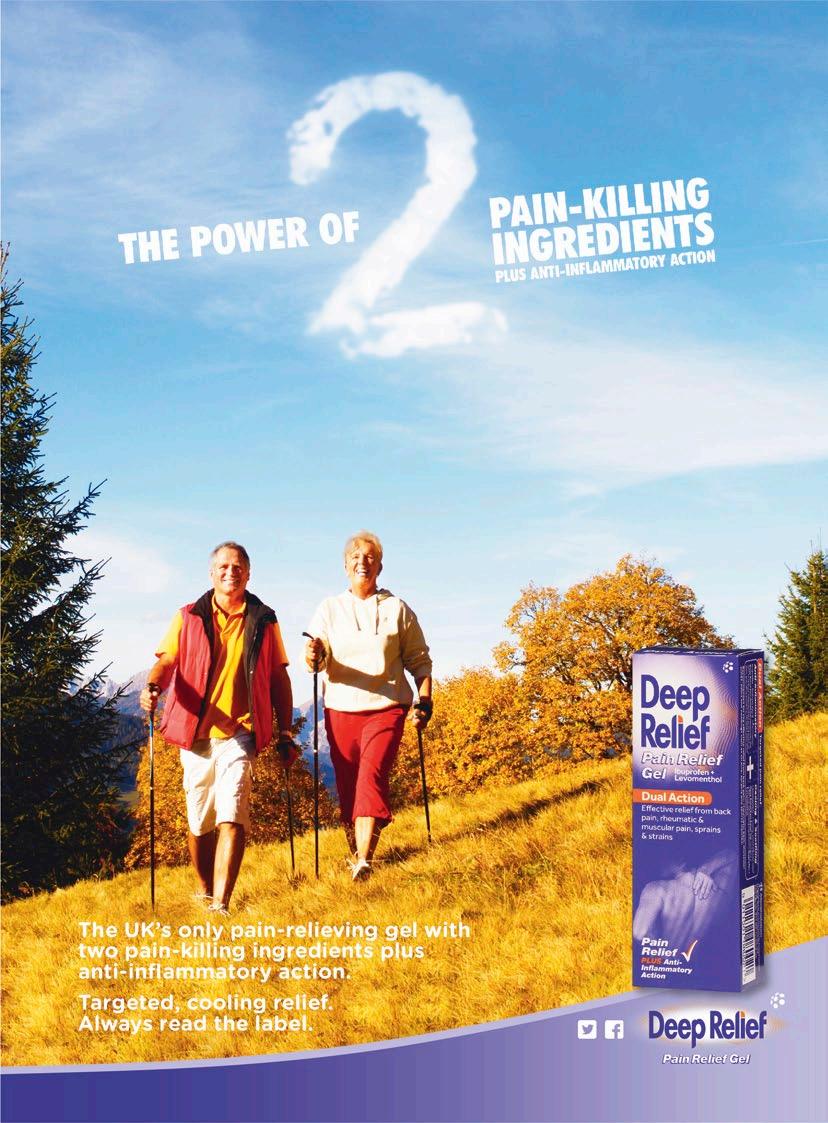

The Eyes Have It
I went for an eye test at my optician’s the other day. Of course, it’s not just your vision that gets the once-over; your optometrist will also check your eye health and more.

“That all looks very healthy,” he said to me, “but out of 20 or so people I see every day, I refer three or four to their doctor or send them to hospital.”
Some people are suffering from eye conditions such as glaucoma, macular degeneration or cataracts. But from a simple eye examination an optometrist is also able to detect signs of diabetes, high blood pressure, an impending stroke, even a brain tumour or multiple sclerosis. A Vision Express optometrist recently discovered brain swelling in a man who’d had a fall, whereas hospital tests had turned up nothing.
In future, we may be able to diagnose early-stage Alzheimer’s from an eye test.
Trials of two techniques identified beta-amyloid protein in the eye. This is present in the brains of people with Alzheimer’s, but up to now it has been difficult to diagnose the condition early, when it’s most likely to respond to treatment.
So while my trip to the optician’s resulted in a rather painful bill for new glasses, the eye examination itself was painless and my eyes were opened to how crucial it is to have one regularly. It’s usually recommended that you have a test every two years, unless you’re diabetic, have a family history of glaucoma or are over 70. Then you might be asked to go more often.
idEnTifyinG A bLind spoT
according to a survey by eye hospital group optegra, 55 per cent of drivers over 65 suffer from glare while driving at night, yet only 17 per cent know it’s a sign of cataracts. The poll found that the majority were also unaware of the other symptoms, including cloudy vision (45 per cent recognised this as being caused by a cataract), becoming more short-sighted even in glasses (only 15 per cent knew about this), colours fading (a mere 10 per cent were aware of this symptom) and double vision (5 per cent linked this to cataracts). an eye test will easily diagnose cataracts, which can be removed in a routine operation.
01•2015 | 57
© caia ima G e/ a lamy
The First Cut Is The Meekest
By max pem B erton

Max is a hospital doctor and author.
He’s also the resident doctor on ITV’s This morning
There’s a firsT Time for every Thing, and this is true even if you’re a doctor. Prescribing medication, taking blood, even telling someone they’re dying; every doctor will have done these things for the first time. Many of these— particularly the big, dramatic things like saving someone’s life—are considered a rite of passage, but there are so many first times when you’re a doctor, you can become a bit blasé about them.
Days are so crammed full that in the morning you might be a complete novice at something that you’re an expert at by the evening. When you go home and reflect, it’s easy to forget how quickly you’d mastered something. However, the first time you cut into someone is something that stays with many doctors for a long time.
i n my firsT job as a junior doc T or in surgery, I was allocated a minor-ops clinic. Because it was minor surgery, the patient was awake and only had local anaesthetic. This meant the operations were quick and straightforward, but the patients were also able to hear that you didn’t necessarily know what you were doing.
The first patient I ever operated on was a man in his 30s. He looked very nervous when I introduced myself in the waiting room and he was sweating profusely. His nerves were only
| 01•2015 58 H ea Lt H
matched by my own. I read through his notes and saw that he’d come in to have a small cyst removed from his scrotum. I’d never done one of these, and before I could say anything he was wheeled in and was on the operating table. He looked up at me with a panicked expression.
“This isn’t going to hurt, is it doc?” he asked, clutching his groin protectively. I cleared my throat.
“No,” I replied. “I shouldn’t have thought so.”
In hindsight, I could have been more reassuring. He swallowed hard. I looked over to the registrar who was supervising me.
“Do an elliptical incision,” she said encouragingly. The man looked at me, even more panicked.
“You do know what you’re doing?” he asked, sitting up from the table.
“Erm, yes,” I said.
A nurse leaned over as I hovered with the scalpel.
“You might want to put in some anaesthetic,” she said.
The man let out a whimper. There was no hiding that my hands were shaking almost uncontrollably.
“Keep your hands steady,” said the nurse as the man gripped the side of the table and tensed.
I was about to make the incision when the man spoke: “My wife is outside and if you slip with that thing, you’ll be joining me in the infertility clinic.”
Thankfully for both of us, the operation went without a hitch.
© shutterstock/file404 01•2015 | 59
You Can Get A Hernia From Lifting Something Heavy

WHere did tHe mytH come from?
I have a sneaking suspicion that this myth was created by men as an excuse to avoid heavy work about the house. Hernias are a weakness in the muscle of the abdomen wall. This allows parts of the bowel to protrude out into a pouch-like bulge. Many people notice that they have a hernia when they lift something, and so assume it was the lifting that caused the hernia.
WHat’s tHe trutH?
Like all the best myths, it’s based on a half-truth. People notice their hernia when they strain, because this increases the pressure inside the abdomen and causes it to bulge out in the area of weakness—the hernia. Although this makes the hernia more obvious, straining or lifting something heavy didn’t actually cause it. Common causes of hernias are age, chronic cough, damage from injury or surgery—or have been present since birth because the abdominal muscles didn’t fuse together properly.
so, tHere’s notHing to Worry aBout?
Most hernias can be easily repaired and should be assessed by a doctor. Hernias are usually harmless, although sometimes the bowel inside them can twist, called a “strangulated hernia”, and this can be serious. If it becomes very painful or can’t be pushed back in, then you should seek immediate medical advice.
i llustration
| 01•2015 60 H ea Lt H
By Davi D h umphries
medicaL
FOR MORE, GO TO readersdigest.co.uK/HeaLtH
mytHs—Busted!





Try... Ultralieve Pro Ultrasound Therapy Aches and pains† holding you back?

Supports the body’s natural healing process
Same technology as used by physiotherapists
ULTRALIEVE uses therapeutic ultrasound to help the body repair sprains and to relieve the associated pain and discomfort so that you can get on with your day.




ULTRALIEVE is a Class IIa medical device that doesn’t mask your pain like painkillers do, it uses targeted high frequency vibrations that penetrate below the surface of the skin, thus supporting the body’s natural healing process.
Therapeutic ultrasound technology is commonly used by physiotherapists in the UK and has been for over 50 years.




† Ultrasound may help to temporarily relieve mild to moderate soft tissue pain.




















ONLY £99 .99 + FREE P&P (Worth £4.95) Full price
or Spread the cost with 1 2 3 4 4 Easy payments of £25.00
£99.99
Drug-free
ultrasound waves e pid er mi s dermi s on average up to 4cm *Instalment plan available on credit/debit cards only and subject to status. An initial deposit is due at time of order and payments will be charged to your credit /debit card. There will be no interest charges from Actegy Ltd but in the event of late payment credit/debit card company charges may apply. Before use read the user’s manual carefully. Use only as directed.If symptoms persist, see your healthcare professional. Copyright © 2014 Actegy Ltd, REFLEX, Cain Road, Bracknell. RG12 1HL. United Kingdom. 6833962 | v1.0 | 12.2014. Call: 0845 871 9900 DRUG FREE CLASS IIa MEDICAL DEVICE Was £149.99 SAVE £50 Now £99 99 +FREE P&P (P&P Worth £4.95) +2 YEAR WARRANTY REF UL08
Winter

With a sprinkle of snow or a touch of frost, the UK’s landscape is at its most magical this time of year
By Lau R a D E a N -O S g OOD
INSPIRE
62
Best Britishof

Stourhead
WILtShIRE
Inspired by the landscape painters of the late 1700s, the gardens at Stourhead’s 2,650-acre estate are as pretty as a picture. At the centre, a five-arched stone bridge sits over a sweeping lake, its edges lined with exotic trees and buildings paying homage to the 18th-century owner’s love of art. Each adornment is arranged to form a waterside walk that’s intended to represent the journey of the Roman leader Aeneas into the underworld.
The art and mythology of Stourhead are evident year-round, and winter is an ideal time to take in its secluded beauty, meander through ancient woodland and visit the UK’s tallest oak tree.
■ Visit nationaltrust.org.uk/ stourhead for details
The Trentham Estate StaffORDShIRE
Mice, deer and even monkeys—the diversity of wildlife within the beautiful grounds of the Trentham Estate is a big draw for visitors. In warmer months, guests can explore the monkey forest where primates roam free, but the wildlife is no less impressive in winter; a herd of black fallow deer inhabit the grounds as well as plenty of voles, badgers, foxes, hares and stoats.
Set within a vast area of woodland, these 300-acre grounds include a lake, deer park, bird hide and 18th-century gardens designed by Capability Brown. Today, the huge Italian garden’s wide walkways lead up to the area where Trentham Hall once stood and have recently enjoyed a revival at the hands
of Chelsea Flower Show gold medalist Tom Stuart-Smith. Designed to interest visitors whatever the weather, head of garden and estate Michael Walker believes winter sees Trentham at its most memorable.
“The vast perennial plantings and formal structure of the Italian garden are enhanced through the early winter by the beauty of defoliated stems and sun-bleached seed heads,” he says. “When combined with snow, or even a hoar frost, the garden provides a picture-perfect experience.”
Winter visitors can enjoy horsedrawn carriage rides, follow the Winter Willow Decoration Trail or take part in a wild weekend of bug and scavenger hunts on January 17–18.
■ Visit trentham.co.uk for details

best of british | 01•2015 64
P re V io U s i MAG e : © rU th hA rlin G / © P hoto co U rtesy of trenth AM

Lowther Castle and Gardens
CumBRIa
Having lain abandoned for over 70 years, the grounds of Lowther Castle are finally coming back into bloom. The 130 acres of gardens and castle terraces are the subject of one of the UK’s biggest restoration projects, which is uncovering the great heritage and exceptional beauty enjoyed in the estate’s heyday. The castle’s beautiful facade and stable courtyard are now restored and include a visitors’ centre and cafe, while the gardens are undergoing continued renewal.
Activity continues all year round, and guests are invited to explore the grounds as they enjoy their reawakening and change with the seasons.
“Working in the gardens at this time

of year is as enjoyable as the summer months,” says head gardener Martin Ogle. “It’s a joy to see the colours of the trees, the autumn fruits and the abundance of wildlife. It can rain quite a lot, but what’s most enjoyable is watching the gardens change day by day. As long as you’re prepared for every weather condition, it’s a great place to visit at this time of year.”
■ Visit lowthercastle.org for details
01•2015 | 65 © r ob Wh A rton

London Wetland Centre LONDON
Nestled in the curve of the Thames at Barnes, the 100-acre London Wetland Centre is a paradise for water birds and creatures, who inhabit the gardens, meadow, marshes and lakes all year round. In winter, the nature reserve becomes home to a huge number of overwintering ducks.
“This is a great time to visit,” says marketing manager Catherine Starling. “The ducks are in their finest plumage and you can even spot Red Admirals on milder days.”
The centre was created from several disused Victorian reservoirs in 2000. And with regulars including kingfishers, hawker dragonflies, rare birds and amphibians, it truly brings the glory of the British countryside to the capital.
■ Visit wwt.org.uk/london_wildlife for details

best of british | 01•2015 66
© cA rolyne bA rber Photo G r AP hy
The Alnwick Garden NORthumBERLaND
This contemporary pleasure garden, which is home to one of the world’s largest treehouses, truly lights up in winter—and it’s not just perennials doing the work, but water sculptures and spectacular light shows.
The grand cascade, a huge series of water fountains, sits as the garden’s centrepiece and puts on water shows every half hour, looking particularly pretty as temperatures drop.
“The structure of the garden really comes into its own during winter,”
says head gardener Trevor Jones. “The water sculptures, rills and the grand cascade become focal points, and bring movement and sound into the garden, reflecting the winter light. Our 250 white Himalayan birch trees create ghostly silhouttes against the winter sky, and then 500,000 snowdrops emerge.”
If you get chilly outside, head up into the branches and warm yourself by the log fire in the treehouse restaurant, or enjoy a drink at the treetop bar.
■ Visit alnwickgarden.com for details

R E a DER ’ S D I g ES t 01•2015 | 67
© Gr A e M e Pe A coc K

Glasgow Botanic Gardens gLaSgOW
Step out of the cold and into the glass houses at Glasgow Botanic Gardens for a taste of the tropical in the middle of winter—the perfect respite from a chilly walk through the surrounding park land that stretches alongside the river Kelvin.
At the gardens’ centre is the Kibble Palace, a grand domed structure built in 1873. The popularity of the gardens in the late 1800s demanded that the site had its own railway station, which now lies derelect (an original ticket kiosk still stands).
There are ten glass houses in total, all home to a huge collection of plants and trees native to warmer climes, including Chile, India, Australia and North America, with some tree ferns over 120 years old.
■ Visit glasgowbotanicgardens.com for details
Pensthorpe NORfOLk
Nature lovers are in their element at this sprawling natural park in the Wensum Valley. Pensthorpe is home to three gardens and a meadow set alongside a series of lakes, with each environment designed to attract different wildlife and create unique experiences all year.
In the wildlife habitat garden, expect to see bats, beetles, garden birds and reptiles, while the acre-wide millennium garden maintains its beauty as the cold creeps in.

best of british | 01•2015 68
© s te V e Vidler/Al AM y / © Anne Green-Ar M ytAG e
“The millennium garden turns into an architectural gem in winter,” claims head gardener Jonathan Pearce. “The seed heads of herbaceous plants such as miscanthus become an excellent winter food source for small birds, and the dried foliage shelters small animals and insects.”
As the seasons change, so do the colours and the light that falls, transforming the gardens thoughout the year. “Winter frosts cling to the plants and create a magical winter land,” Jonathan says. “It’s not to be missed.”
■ Visit pensthorpe.com for details


Aberglasney Gardens
CaRmaRthENShIRE
With the idyllic Tywi Valley as their setting, these gardens tell the tales of the generations of families who have inhabited the grounds since the 1200s. The Elizabethan promenade is said to be the best preserved of its type in the UK and forms part of the grounds that surround the historic house.
Wander through the yew walk, a tunnel formed of ancient trees, or visit the pool garden, where a new teetotal owner allegedly emptied the contents of the previous inhabitant’s wine cellar. Walkers can spy a range of centuriesold American evergreens in the church view garden, and take in the upper walled garden before enjoying a winter warmer in the cosy tearooms.
■ Visit aberglasney.org for details
Do you know a winter garden that’s worth a wander? tell us about it by emailing readersletters@readersdigest.co.uk
01•2015 | 69 R E a DER ’ S D I g ES t
© P hoto co U rtesy of A ber G l A sney GA rdens
Story competition 100 Word
Entries are flooding in to our annual shortstory competition! Take inspiration from these two stories and send in your effort—time is running out!
Terms and Conditions
■ Please send your stories—which should be original, unpublished and exactly 100 words long—to 100wordstory@readersdigest.
co.uk by January 31, 2015.
■ There are three categories—one for adults, and two categories for schools: one for children aged 12–18, and one for children under 12.
■ In the adult category, the entry voted best by the editorial team will receive £500, and two runnersup will each receive £75.
■ In each of the school categories, the prize for the winner is £250 of high-street vouchers of their choice, and £250 for their school, and two runners-up will each receive £50.
■ Mark each entry either “Adults”, “Schools 12–18 category” or “Schools under-12 category”. Winning entries will be published in a future issue.


























| 01•2015 70 Q W E R T Y U I OP A S DF GH J KL ZX C V B N M
INSPIRE
Sophie McKenzie
His office is empty. I circle the desk. Her photo rests against his computer: Mr Pitiless and his smiling whore. Footsteps echo outside. His beautiful, treacherous face in the black glass of the window. He strides in, eyes wide. “What are you doing here?”
The fist around my heart threatens to squeeze.
“It’s not a good time. I have a meeting.”
“I know.”
A line creases his forehead. “What?”
I stand up. Walk over. “I am the meeting.”
“I don’t understand,” he says. “What’s this about? What are you here for?”
I take the knife from behind my back. “You.”


■ Sophie McKenzie is an awardwinning author. Her latest crime thriller Trust In Me (£7.99) is available now.
Rules: Please ensure that submissions are original, not previously published, and are exactly 100 words long. Don’t forget to include your full name, address, email and daytime phone number with all correspondence. We may use entries in all print and electronic media. We cannot acknowledge or return your story. Do not send SAEs. Contributions become world copyright of Reader’s Digest.
Stuart MacBride
His fingers tremble against hers —breath ragged, then fading. Then silence.
Margaret wipes her eyes.
It looks as if Colin’s crying too, but it’s just tears of condensation rolling down the inside of the freezer bag over his head. He’s so peaceful. So still. Gone before the chemotherapy could get its claws into him.
After all, who wants to die of a brain tumour? Much more dignified this way.
Margaret smiles down at him. It took three dirty weekends in Cornwall to get Doctor Phillips to fake Colin’s test results, but it was worth it.
Poor gullible, rich, old Colin.


■ Scottish crime writer Stuart MacBride’s latest novel
The Missing & the Dead (HarperCollins, £16.99) is out this month.
Entry is open only to residents of the UK, Channel Islands, Isle of Man and Republic of Ireland. It is not open to employees of Vivat Direct Ltd (t/a Reader’s Digest), its subsidiary companies and all other persons associated with this competition, their immediate families, and relatives living in an employee’s household. The judges’ decision is final.
01•2015 | 71
ILLUSTRATION
LEWIS/ALAMY
©
BY KATIE JOHNSON / © GERAINT
as Europe’s population ages, older people are teaming up in imaginative ways to live together and help each other
Better TogeTher
By tim B ouquet
It could be a scene from any shared flat. In a leafy Hamburg suburb, Irene Westphalen is making coffee while Wilhelm Gutmann is setting the table for dinner. They are both teasing flatmate Peter Rohwer for never folding his clothes properly.
“Well, he did bring down the rubbish,” Gisela Mosner says, coming to her flatmate’s defence.
The only clue that this flat is not typical is that the phone numbers fixed to the fridge are in unusually large handwriting. The five residents
| 01•2015 72 illustration by paul blow
i NSP i R e
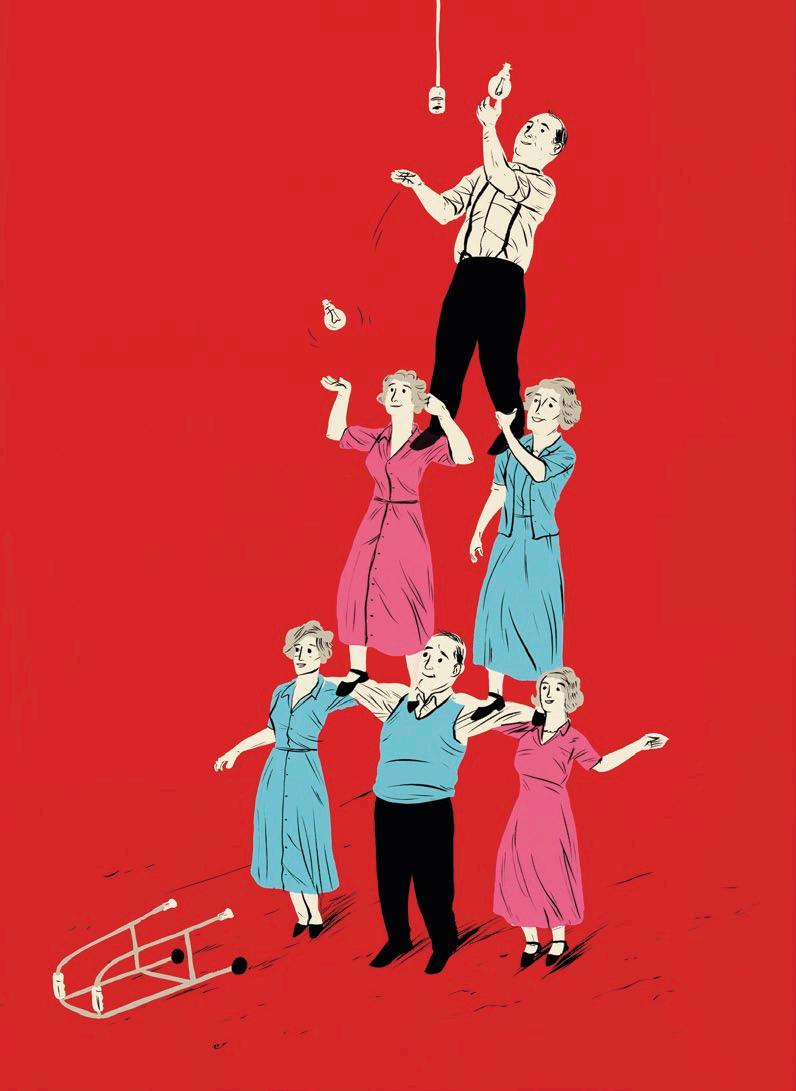
are aged between 74 and 85, and they have chosen to live their later years together instead of seeing out their days in a cheerless care home or living alone with memories as their only companions.
The laVida flat—from the Spanish La vida , meaning life—is the brainchild of Karin Hillengass, an energetic 60-year-old social worker who studied housing for older people at Hamburg University.
“I learned that what older people fear most is loneliness and having nobody to talk to,” she says. Three years ago she decided to establish laVida.
There are 92.3 million Europeans today over the age of 65, twice as many as there were in the 1960s, but increasing numbers of them are pioneering alternatives to life in a care home. Germany has Europe’s highest proportion of over-80s, some three million or 3.6 per cent of its population, and Hillengass believes there’s a way for the elderly to continue living independently in the community, to organise their lives and their care and remain autonomous.
From her contacts, she approached seven senior citizens who were each living alone in Hamburg and explained her vision. The seven began meeting socially to see if they got on and to look for possible apartments. The seven became five after two opted out. They chose this flat because the
underground, bus station, shops and supermarkets are close by.
“We know where to get the best liverwurst,” says Peter Rohwer, who’s lived here from the start. The “baby” of the group at just 74, he worked as an electrician and likes making model ships. Irene Westphalen, a widowed housewife born in 1929, is the oldest and joined at the same time as Peter.
Slim, well-groomed and with sparkling eyes, she says that shared living is great for “those who remain open towards others and curious for what life brings. Also, you’ve got to be generous. It’s all give and take. There’s a balance, but we don’t keep books on that!”
“There’s always something going on. It is no more expensive than an old people’s home, but much more personal”
The third-floor apartment, which is serviced by a lift, has five bedrooms, a big kitchen and living area with a suntrap balcony, wide corridors for wheelchairs and walkers, and two bathrooms equipped with sit-down showers, handrails and non-slip floors. Each resident has an emergency button by their bed and their own phone. They pay monthly rent of between €168 and €480, depending on the size of their room.
“When we found the apartment we
| 01•2015 74 b E tt E r tog E th E r

faced a problem,” Karin Hillengass explains. “No landlord would want to sign five leases for one apartment and if all five tenants signed one lease as a group there would be a problem if somebody withdrew or died. We had to find another way.” That third way is a businessman acquaintance of Karin’s who acts as an “intermediate landlord”. He signed the lease with the owner and the tenants pay rent via him.
Failing health often forces older people into institutions, but the laVida apartment is served by a mobile nursing service of five nurses who work a 24-hour rota and also help with shopping, cooking and cleaning. It costs each resident between €1,000 and €2,500 a month, but most is covered by insurance and state support.
Karin, too, spends up to 15 hours a
Good company: Peter Rohwer and Irene Westphalen relax in the kitchen of their communal flat in Hamburg, Germany
week with the tenants. Two of the original five have died and been replaced by new members; a third suffers from dementia. She stays happily in the apartment thanks to the nursing and support from her fellow tenants.
The laVida flat sharers go on outings to the North Sea coast or to theatre productions, such as The Lion King. At home, they play games or chat and laugh around the big kitchen table. They each have their own television but watch much less than when they lived alone.
“There’s always something going on,” Irene Westphalen says. “It’s no more expensive than an old people’s
Reade R ’s d igest 01•2015 | 75 u lrik E s chmidt
home, but it’s much more personal. There are no house rules, so if you don’t want to get up in the morning you just stay in bed. And often somebody will bring you some coffee.”
starting young
As Europe’s population gradually ages, the number of options for older people living together is noticeably proliferating. Key to success is forward planning, and that was certainly the case with a group of four Dutch couples thinking about their future.
Back in 1985 the couples, all in their fifties, founded De Kamp, a community for older adults in Bunnik, a rural village of 15,000 inhabitants near Utrecht. They formed an association and clubbed together to buy a farmhouse and a piece of land.
manager, a managing director of a bread factory, a medical nurse, a professor of veterinary sciences and a pharmacy assistant. “We were all actively involved in church-related community work and social-political organisations like the peace movement,” Janny explains.
“We felt we should take care of ourselves. One of us floated the idea of buying a property where we could all live”
“We became friends and went on holiday together. One evening we were sitting around the campfire with a glass of wine, discussing our ageing parents who had never stopped to think about their old age and just moved into a care home. We felt we should take care of ourselves. One of us floated the idea of buying a property where we could all live and look after each other.”
Each couple paid for and built an identical private house for themselves —with ground-floor bedrooms and bathrooms—around the communally owned farmhouse they use for parties and events and shared facilities such as washing machines.
“We met in our forties,” says Janny Koops, a 77-year-old pastoral worker who was a founding member with her husband Teus. Back then, the other six founders numbered a human resources manager, a hospital technical
Before embarking on their change of life they attended a special training weekend. “We learned how to handle conflict, the need for tolerance, structure and rules when living in a group,” says Janny. “Maybe the most important thing we were made aware of was the need for sufficient privacy, hence the private houses and the communal farmhouse.”
Of the eight who started De Kamp, three have died and the others are now in their seventies and eighties. “The three deceased members of our community all lay in state in the farmhouse before their burial,” Janny says.
| 01•2015 76 b E tt E r tog E th E r
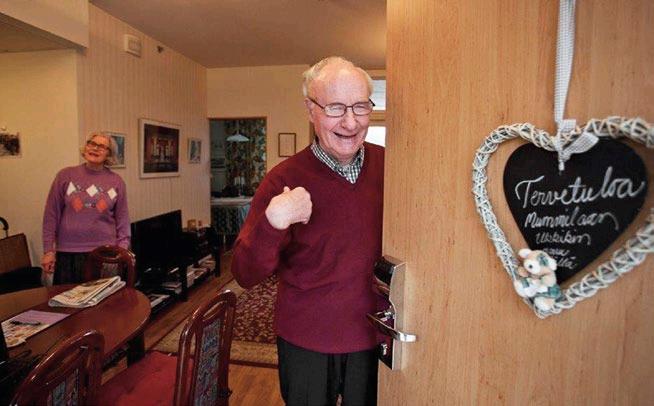
“When Greetje [a retired pharmacy assistant] had acute leukaemia she said she wished to die at De Kamp and we all helped out as care-givers, doing housekeeping or just sitting with her, although medical care and washing was done by professionals.” Two new residents, a communications manager and a climate consultant, are both in their forties. Just like their trailblazing De Kamp neighbours they saw the need to plan early for old age.
“hotel” apartments
Other options for living a sociable old age are much more off-the-peg. Some people, for instance, may prefer a hotel apartment-style lifestyle with healthcare and leisure facilities all under the same roof.
Retired primary-school headteacher
A heart-shaped welcome: Osmo and Annneli Lindroos enjoy hotel-style facilities in Turku, Finland
Osmo Lindroos, 77, lives in Saga Senior House Kaskenniitty in Turku in Finland with his wife Anneli, 76, who used to teach English. The development boasts a restaurant, sauna, swimming pool, hairdresser, podiatrist, room service and staff always on call. The couple moved in more than six years ago from only a few miles away.
“We have never regretted that we moved here,” Osmo says. “The nursing staff are well trained and friendly, and you get help 24 hours a day. Anneli and I can still keep an eye on each other, but for those who live alone it’s extremely important to get help quickly. The restaurant offers excellent
Reade R ’s d igest 01•2015 | 77
JANUARY




If you are searching for the finest hand-built leather upholstery without the usual extravagant price tags, then you need to look no further than the latest Thomas Lloyd brochure.
By selling direct from our factory you get furniture at Trade Prices and of a far higher quality than you would from your local shops.
For your free colour brochure: Call 01443 771222 or visit www.thomaslloyd.co.uk

Direct from the factory quality leather sofas and chairs
SALE NOW ON
Georgian Wing chair was £799 now £529
Senator Electric Recliner was £1329 now £899 Canterbury Wing chair was £899 now £599
Regent Wing chair was £859 now £599
food and they gladly take all kinds of special diets into consideration. But when Anneli wants to cook herself— she doesn’t want to lose her touch —she can do it in our own kitchen. I cannot think of anything negative to say about this way of living.”
Saga Senior Houses are constructed by the non-profit Ruissalo Foundation and situated in Turku, Rauma and Helsinki. Apartments vary in size and residents can furnish to their own taste. A 470 square-feet flat costs €1,350 a month and includes rent, water, electricity, panic button, supervised leisure activities, cleaning once a month, lunch daily and a plan for care, service and rehabilitation.
Terminal care is also provided, so
the gRey CoNtiNeNt
92.3 million (18.2%) of Europe’s 507 million population is over 65.
italy (21.2%), germany (20.7%) and greece (20.1%) have the highest proportions of over-65s
11.8 million (2.3%) Europeans are over 85
26,000 europeans celebrated their 100th birthday last year.
Source: Eurostat 2013, based on EU-28
residents can stay as long as they live. They can also apply for benefits from the city council or the Social Insurance Institution of Finland (Kela) and some services are tax-deductible.
women only
Women generally live longer than men and single-sex communities provide yet another approach to living out a pleasant old age. French women, for instance, live on average 6.7 years longer than French men and enjoy the longest life expectancies on earth bar Japan and Spain.
In 1999 Thérèse Clerc, then 72 and divorced with four children, dreamed of a place where intelligent, dynamic women could grow old together without having to be cared for by strangers. A lifelong feminist from Montreuil, on the east of Paris, she began lobbying local government to help fund a self-managed housing project where women could keep their independence but live communally.
After a nine-year campaign, La Maison des Babayagas (Baba Yaga is a kind of witch in Slavic mythology) became a €4 million, five-storey reality in central Montreuil, with funding from eight different sources. There are 21 self-contained flats, purpose-built for the elderly.
“It was a long fight to get us here and we’re here to stay,” says Thérèse, now 87 with a shock of white hair, breaking into a smile.
“All applicants are interviewed first
01•2015 | 79
Reade R ’ S d ige S t
Introducing the all new Gtech Multi
AirRam’s perfect partner































“Convenient, easy AND powerful”



 Mrs. L. Rodgers
Mrs. L. Rodgers
“This cleaner is amazing! It’s easy to use, does a great job of the skirting boards, stairs, curtains... and it’s cordless. It has no trouble removing the black cat hair from the sofa! I don’t miss my heavy old vacuum.”











“Using the attachments on a traditional upright vacuum can be a real pain. Dragging it round from plug to plug; the hose still never seems to reach far enough; not to mention the cumbersome weight. We’ve designed the powerful, lightweight Gtech Multi to make all those problems disappear.”
Nick Grey – Inventor, Owner

Cordless freedom

of Gtech
In 2012 we launched the critically acclaimed AirRam, allowing you to lose the weight and the cord, whilst keeping the performance of mains powered upright vacuums (10/10 Is this the best vacuum cleaner ever? Daily Mail).*
Now we’ve developed the Multi: The attachments you’re used to on your upright vacuum and great cleaning performance all rolled into a cordless hand-held solution.
High performance
Upright mains vacuums can be heavy. Cordless, hand-held vacuums are lighter, but may leave you disappointed with poor performance.
The Multi delivers high performance cordless cleaning right into the palm of your hand – giving you the freedom and versatility to make short work of edges, stairs, upholstery, curtains and even the car interior. Multi’s upholstery tool is also ideal for removing pet hair.
Long run-time
With up to 30 minutes run-time, the Multi outlasts the leading cordless hand-held vacuums.†


Powered by a professional-grade Lithium-ion battery, Multi is fully charged in just 4-hours. Alternatively, Multi can deliver a burst of additional cleaning with a short 1-hour charge. An easy to read LED display lets you know how much charge is left in the battery, so you won’t be caught short.
Attachments on-board
Multi is armed with a full set of attachments (crevice tool, dusting brush and upholstery tool) to help you get into those nooks and crannies. It even conceals a flexible hose that pulls out, allowing you to reach into those really awkward spaces. Pull the trigger and Multi’s integrated lights illuminate the target cleaning area, leaving nowhere for the dirt to hide.
Don’t bend down to clean skirting boards – Order your Multi direct from Gtech today and receive a free 36cm (14-inch) extension tube.
You can love vacuuming…
At Gtech, we believe there’s got be an easier way to clean your home. From our British headquarters, we’re busy creating uncomplicated, easy to use technology to make your life easier.






















 Don’t bend down to clean skirting boards
Make short work of stairs
Don’t bend down to clean skirting boards
Make short work of stairs
Watch our online demo
+
EXTENSION TUBE
ORDER DIRECT: £149
FREE
83 53 www.lovevacuuming.com/multi We are able to offer the Multi at £149, with free delivery and a free 36cm extension tube, when ordering direct. While stock lasts. Gtech are also offering the AirRam and Multi for a combined price of £299 (includes free Multi extension tube). That’s a saving of £49 off RRP (Gtech AirRam £199 / Gtech Multi £149). Call or see website for details. “10/10 Is this the best vacuum cleaner ever?” Daily Mail THE ULTIMATE CLEANING SYSTEM SAVE £49 Multi: Limited 2-year manufacturer’s warranty. AirRam: Limited 2-year manufacturer’s warranty. *Performance comparisons based on independent tests to IEC 603121 ed 1.1 sec 5.1 and 5.3 when compared to mains powered upright vacuums (Source: GFK, UK Top 20, 2013). †Source: GFK UK Top 20 cordless hand-held vacuums, 2013. Runtimes quoted may vary depending on surfaces cleaned and attachments used. Free delivery to UK mainland addresses (including Highlands). Full details on our website. Grey Technology Ltd. t/a Gtech, Cupola Court, Spetchley, Worcestershire, WR5 1RL.
0800 051
to make sure they will fit in,” she says. “There’s a panel and we make the decision collectively. We’re aged between 58 and 88 so, although we may be old and retired, there’s an entire generation between us and that’s what makes it work so well.”
Residents pay an average of €420 a month for 380 square feet of living space. Many volunteer in the local community and most have strong feminist beliefs. There are organised events, meals and activities, and although the idea is that residents take part in a “vie collective”, privacy is respected and independence encouraged. If someone becomes too ill to take care of themselves, they then move to hospital.
One of the residents, Odile Razafimandimby, 66, a retired painter and writer, says: “Ever since we moved in together, it’s been about solidarity. We eat together, we help each other
out and if one of us is unwell, we all pay them a visit.”
Similar Babayagas projects are now under way elsewhere in France. “We want to change the way people see old age,” says Thérèse, who has received the Légion d’honneur for her work.
“La Maison des Babayagas is for women who are getting older but want to look after themselves right up until the end—to go through the last stage of life with dignity and tenderness.”
While governments across Europe have a financial interest in encouraging alternatives to state-funded care homes, it remains up to individuals and couples themselves to plan for an old age that avoids isolation, loneliness and dependency. As our stories show, innovative schemes are springing up precisely to address that need.
Additional
S ee me afte R C la SS
what’s getting students a detention these days? according to distractify.com, some rather unusual things:
Reason: Volunteered to be a target for a paper plane. was hit in the face with it.
Reason: caught lucas searching “boobies” while other students were looking at photos.
Reason: disrupting class by standing, unbuttoning his shirt to reveal a superman t-shirt and announcing he was superman.
Reason: when a student asked another student what he was doing after school, he responded, “your mum.”
Reason: shaving his beard in class.
01•2015 | 81 Reade R ’ S d ige S t
reporting: Lisa Donafee, Barbara Erbe, Paula Herranen, Hans Scholten
Arianna Huffington is editor-in-chief of news website
The Huffington Post. She was listed as the 52nd most powerful women in the world by Forbes magazine
If I Ruled the World Arianna Huffington
We’d spend more time pondering the Big Questions. “What is a good life?” is a question asked by philosophers going back to the Ancient Greeks. But somewhere along the line we shifted our attention to how much we can make, how big a house we can buy and how high we can climb up the career ladder.
Nurturing our human capital would come before building our financial capital. My mother was an expert at that. When I was 12 years old, a successful businessman came over for dinner. He looked run down and exhausted, but he told us how well things were going. “I don’t care how well your business is doing,” my mother told him, “you’re not taking care of you.” And indeed, not long after that, the man had to be rushed to hospital for an emergency angioplasty.
I’d banish electronic devices from the bedroom. At the end of the day we’d turn off all our devices —and gently escort them out of the bedroom.



INSPIRE | 01•2015 82
illu S tr A ted by J A me S Smit H
Disconnecting from the digital world helps us to reconnect to our wisdom, intuition and creativity.
Our leaders would be praised for occasionally taking a holiday. I love the story of Roosevelt taking a tenday holiday in 1940. He’d just come out of the election, victorious. But Britain was running short of supplies and money. Meanwhile Germany was building capacity. The possibility of the US loaning Britain money was raised inside the White House, but Congress would surely not approve. So Roosevelt used a timely getaway to summon the creative power needed to crack the dilemma.
Would our politicians today have the wisdom and confidence to get away, think and refuel? They’d be more likely to if we did our part by helping to change incentives.
I’d make mindfulness a cardinal virtue. When I first heard about mindfulness I was confused. I thought I needed to empty my mind rather than focus on it. Then I read Jon Kabat-Zinn’s writings on mindfulness and it all made sense. “In Asian languages,” he wrote, “the word for mind and the word for heart are the same. So when we hear the word mindfulness we have to inwardly also hear heartfulness to grasp it even as a concept, and especially as a way of being”. In other words, mindfulness is about our whole beings.
I’d reverse the stigma of workplace burnout. At The Huffington Post we don’t celebrate working round the clock and we certainly don’t tolerate bragging about it! There’s a desperate need to change our workplace culture so that working all hours and walking around like zombies is stigmatised instead of lauded.
Everyone would take more naps. Researchers have found that even short naps can help us correct course. Famous nappers have included Leonardo da Vinci, Eleanor Roosevelt and Winston Churchill.
We would all walk more. One of my favourite phrases is solvitur ambulando, which means “it is solved by walking”. It refers to the philosopher Diogenes’s response to the question of whether motion is real. To answer, he got up and walked. In our culture of overwork, burnout and exhaustion, how do we tap into our creativity, wisdom and capacity for wonder? Solvitur ambulando.
Sleep deprivation would no longer be equated with virility. I once had dinner with a guy who bragged he’d only had four hours’ sleep. And I felt like saying to him, “If you’d had five hours’ sleep, this dinner would’ve been a lot more interesting”.
Arianna’s 14th book Thrive (£8.99) is out now.
01•2015 | 83
FOR MORE, GO TO READERSDIGEST.CO.UK/INSPIRE

In a remote bay off Finland’s coast, six friends—all experienced anglers— stepped onto the frozen sea
By Simon Hemelryk
Nightmare On Ice
84 travel & adventure
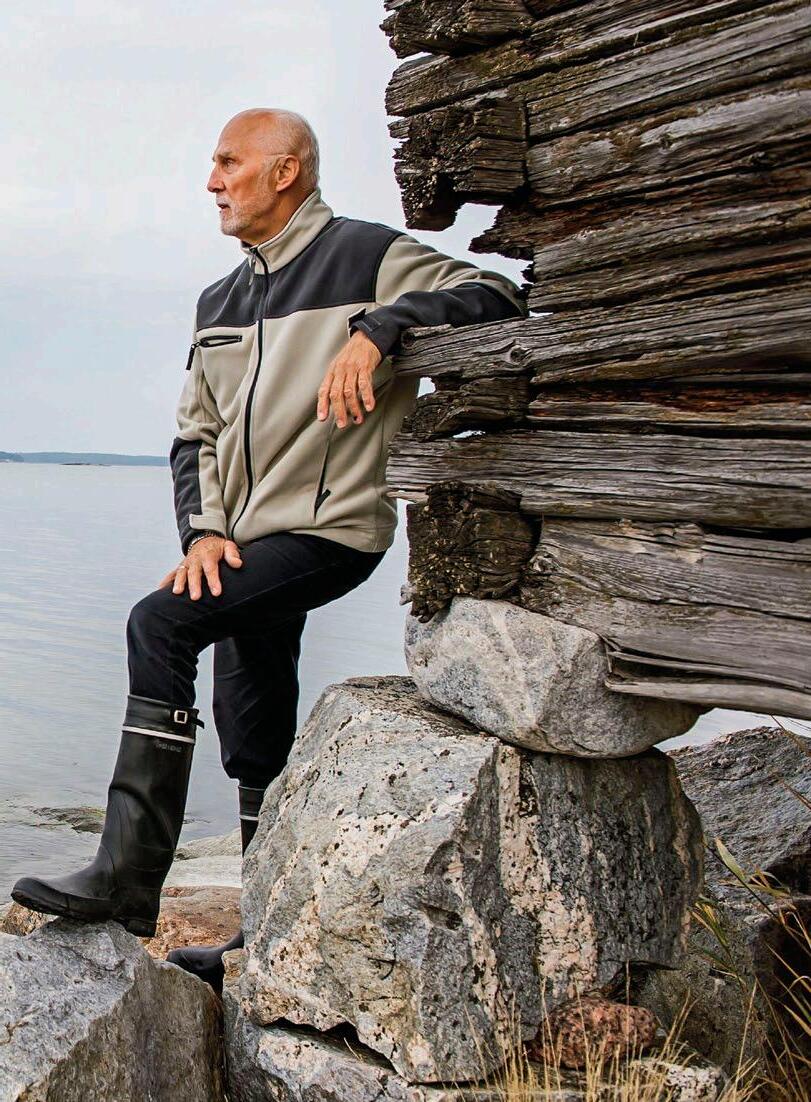 Seppo Makela looks over the bay where he did “something remarkable”
Seppo Makela looks over the bay where he did “something remarkable”
seppo makela wasn’t a happy man that morning. “I really can’t come, soile,” the 63-year-old taxi owner and driver grumbled at his wife in their smart, modern flat. “I absolutely must go and work on the summer house.”
the couple, from rauma, a small port on Finland's south-west coast, owned a wood-panelled chalet by the sea. he was supposed to be getting the chalet ready for a plumber to work on.
But he was going to miss a treat. Friends had invited them on an ice-fishing trip to a remote sea bay called Marjuksenranta, around 62 miles south of Rauma. One of the friends, Lars Erkkilä, had boasted about the huge perch he’d caught there recently.
“You must go without me,” Seppo told Soile nobly. But he was disappointed. It was March 19, 2012, and the ice would soon be melting—no more fishing for another year. Seppo watched petite, grey-haired Soile, 64, packing her lunch. Lars was coming to pick her up at 8am. “Oh, damn it, I’m coming,” he said. Soile grinned. The work at the chalet could wait.
The others were delighted to see Seppo ready with his fishing gear as they drove up to the Makelas’ building. With Lars and his partner Pirjo Laine were Paavo and Ritva Salminen. Paavo, 75, had been a taxi owner and driver in Rauma too, and for more than 35 years he and Seppo had covered each other’s shifts at short notice and organised charity events in the local taxi society. Ritva and Soile also helped at the society and the two
couples, who Seppo reckoned just had a certain “chemistry”, would even go on holiday together.
At least once a week from January to March, the friends would go ice fishing off Rauma’s island studded, tree-lined coast, eating, drinking and chatting while huddled over small holes in the sea ice waiting for a bite. “You’d tease me for the rest of our lives if I missed out and you got a big haul,” Seppo smiled.
The group split into two cars, with Seppo and Soile following Lars. It was chilly, about 5C, but sunny, and they gazed out at the beautiful countryside on the long rural road to Marjuksenranta. Colourful farmhouses punctuated mile after mile of forest, and every so often a crane would land in a nearby field.
Turning onto a track that ran for a mile through the woods, they arrived at Marjuksenranta. The frozen bay was just over a mile wide, dotted with tiny tree-covered islands. In the distance, empty summer houses peeked out from the woods. On the rocky beach Seppo noticed some old abandoned rysakëppi—16-feet-long poles used to
photo's:
| 01•2015 86 n I ghtmare on I ce
esa urhonen
support fishing nets. What are they doing there? he wondered.
To the group’s surprise, they were the only people there. Still, they had no reason to be wary—recent nights had been below freezing and Seppo had been fishing a few days earlier at a regular spot near Rauma where conditions had been fine.
The group put on spiked boots, backpacks and warm layers of clothes. Dragging two sleds full of food and fishing equipment, Lars and Paavo, followed by Pirjo, a smiley 65-yearold redhead, headed out onto the
tired. She looked down at the ice. Rather than being the usual white, it had a slight blue-grey tinge. Some 500 feet from shore, she called to Lars, “As there’s no one here, don’t you think we should test the ice?”
Lars agreed, and drove his hand drill down into the frozen surface. Suddenly, there was a sharp crack and the drill plunged into the water, taking Lars with it. The ice should have been at least a foot thick, but unbeknown to the group, fast-flowing currents at just that spot had caused it to thin to less than half that depth.
To The group’s surprise, They were The only people There. sTill, They had no reason To be wary—recenT nighTs had been below freezing
ice. Brown-haired Ritva, 75, who’d recently had an operation on her leg, was a little way behind.
Seppo and Soile remained on the shore as they fiddled with a zip on Soile’s overalls. “Get on with it,” teased Seppo. “The big fish are waiting.”
a lready on the ice, Lars pointed towards the spot they were heading, about 1,500 feet away, close to an island.
“Do we really have to walk all that way?” Ritva asked, already a little
Still, Lars, plump, bald and redcheeked, was known for fooling around. “Come on, get out of there!” Paavo chuckled and offered his hand to pull him out. Paavo, stocky and slightly bent, had no reason to think the ice beneath his feet wasn’t safe. But as he leaned across, with Pirjo by his side, the ice cracked further and Paavo plunged into the water too, followed moments later by Pirjo.
They clung to the edge of what was now a hole ten feet wide. It might have been easy to climb out using their ice
01•2015 | 87 r eader’ S d ige S t
picks, but to his dismay, Lars realised they had left them in their rucksacks, rather than tied round their necks as was common practice. Lars managed to get his elbows onto the ice, but it broke beneath him.
Ritva pushed a sledge close to the hole and threw its thin strings to Lars and Paavo. But, growing cold and tired incredibly quickly, they couldn’t pull themselves out. Even if she could get close enough without the ice breaking,
moment, turned and ran back towards the shore.
“Hey, don’t go that way!” shouted a confused Soile. But Seppo had a plan. He picked up one of the abandoned rysakëppi and dragged it back towards his stricken friends.
Meanwhile, Soile hurried to the hole and was reaching out with her ice drill in the hope that the others could grab it. But she couldn’t stretch far enough. Lars and Pirjo called for help; Paavo
They'd now been in The waTer for some four minuTes.
“Try To calm down,” said seppo. “iT’s going To be oK”
Ritva didn’t have the strength to get them out, so they were left clinging on to the string, with Paavo trying to support Pirjo with his leg.
Two minutes passed. The water was just above freezing and no one could stay conscious for more than around 15 minutes—particularly older people. Death would come soon after that.
Meanwhile, Seppo and Soile were making their way onto the ice, chatting happily. Seppo looked across to his friends. He could see Ritva, but where was Paavo? Where was Lars? Then he saw the large hole in the ice with his friends’ heads and arms barely visible above the surface. “Damn it, they’re in the water,” he said. He paused for a
was silent. But even if there had been anyone to hear them, the hum of a fish processing plant just around the bay drowned out their screams.
Finally, Seppo arrived with the pole. By now Ritva was very worried about Pirjo. She had heart disease and her lips were turning blue. She’s a goner if we don’t get help fast , Ritva thought. Lars looked across at his partner as he felt the chill spreading through his body. They'd now been in the water for four minutes. “At least save Pirjo,” he shouted at Seppo.
“Try to calm down,” said Seppo. “It’s going to be OK.”
Seppo, bespectacled, balding, but tall and imposing, reached out with
n I ghtmare on I ce | 01•2015 88
the pole. Pirjo grabbed it but hadn’t the strength to hold it tight enough for Seppo to pull her out.
Seppo edged closer to the breaking ice. He put the pole at right angles to the hole and put his foot on it for support. He stretched down and grabbed Pirjo by the collar of her overalls. With a great heave, he pulled her out.
Immediately after, Seppo put his foot back on the pole, but by now it was resting across two pieces of breaking
all the time. So this will be my burial place, Paavo thought.
But the tall, strong figure of his old friend Seppo grabbed his hand and pulled him to safety. Pirjo had by now stumbled towards the shore. Worried, Paavo followed her. Meanwhile, with some eight minutes gone since he’d fallen in the freezing water, Lars was running out of energy—and hope. He weighed 14 stone. He knew he’d be harder work to pull out. Only his face
“you had nerves of sTeel,” paavo said.
“your Know-how, your sTrengTh. everyThing was jusT righT”
ice with frigid water in between. He’s putting his own life on the line now , thought Ritva.
Seppo could see the danger and told Soile to bore her drill into the ice and leave it there, so that he could rest the pole behind its auger. She did so, but the drill plunged through the ice. Fortunately, the ten-inch drill brace got stuck—with just enough protruding for Seppo to jam the pole behind. It wasn’t particularly secure but it was secure enough to provide a base to try to reach Paavo.
Still, precious seconds flew by and the 75-year-old could feel his hands starting to freeze. The hole was now more than 15 feet across and cracking
was above the surface. He was sinking into the 100-foot-deep water.
Seppo tried to remain calm and calculating. “It’s OK,” he said. “I’ve got this covered.”
He stepped across the ice and drilled a new hole closer to Lars. He jammed his foot behind the auger, reached out with the pole and pulled Lars towards him. He grabbed hold of what was almost a dead weight and, adrenalin pumping, somehow hauled him out onto the ice in one movement.
Lars made his way to safety, but Seppo had one last mission. He reached out towards two of the backpacks floating in the water. “Get out of there!” the others called. But Seppo
01•2015 | 89 r eader’ S d ige S t
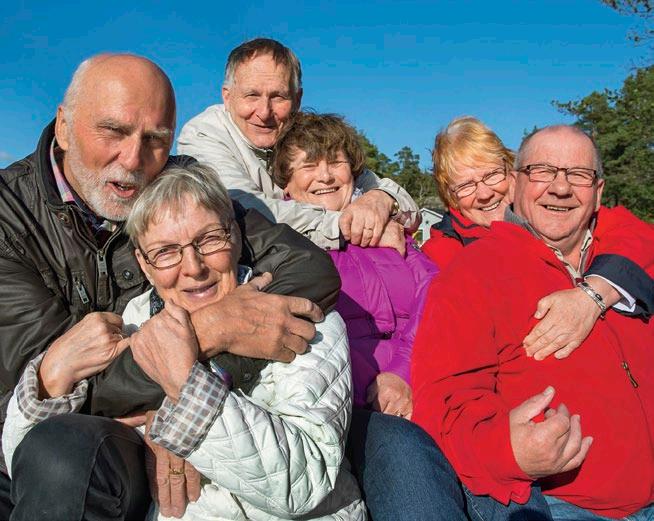
scooped up one of the backpacks and then, finally, moved away from the hole. “I’m stingy!” he explained later.
B ack on the B each, a tearful, exhausted, shivering Lars hugged Seppo. “We’re nominating you for a medal, that’s for sure,” he said.
“Take your clothes off and get changed,” Seppo replied firmly. He, Ritva and Soile took off some of their own overalls and jumpers to give to their friends.
Everyone was quiet. It wasn’t until
they started to drive home that the shock of what had happened really hit them. As they passed a lay-by on an isolated bend in the road, Lars suddenly had to pull over. He paced up and down for ten minutes before he was calm enough to drive again. His passengers were all sobbing too.
That evening, Paavo called Seppo. “I’m grateful that you’ve given me this extra time,” he told him.
Still, that night Seppo couldn’t sleep. He went over and over how he could have done things differently;
| 01•2015 90
From left to right: Seppo and Soile, Paavo and Ritva, and Pirjo and Lars.
n I ghtmare on I ce
The friends are all much closer now
how his actions could have caused four or five deaths, not saved them.
“You had nerves of steel,” Paavo reassured him later. “Your knowhow, your strength. Everything was just right.”
But the incident profoundly affected everyone in the group. Seppo and Paavo are the only ones to have tried ice fishing since—just once—and Soile refuses to go to that spot ever again. Lars feels enormous guilt about what happened and still cries at the memory. Ritva and Paavo think about the accident every day.
“Finns don’t show emotions,” says Ritva. “But at night we go to bed holding hands, thinking, Here we are .”
accident has only brought us closer.”
Pirjo agrees. “I’ve told Seppo that there won’t be a time when we meet when I don’t hug him—whenever and wherever we are.”
“I’d always thought of myself as mentally weak,” reflects Seppo. “I thought if I came across an accident in my taxi, I wouldn’t be able to cope. Fortunately, I was wrong. At least once in my lifetime, I’ve done something remarkable.”
“And to think you weren’t even going to come on the fishing trip,” adds Paavo. “Well, you caught some pretty magnificent fish in the end!”
on may 17, 2013 seppo was presented with the prestigious life saving medal at a special ceremony in nearby turku.
“But,” says Seppo, “we've been close to the Salminens for decades, and the d on’t call u S , we’ll call you
recruiting website careerbuilder.co.uk asked employers to dish the dirt on their very worst interview candidates:
applicant popped out his teeth when discussing dental benefits.
applicant kept her ipod headphones in during the interview.
applicant set fire to the interviewer’s newspaper while reading it when the interviewer said, “impress me.”
applicant arrived in a jogging suit because he was going running after the interview.
applicant checked Facebook during the interview.
applicant answered a phone call for an interview with a competitor.
applicant wanted to know the name and phone number of the receptionist because he really liked her.
01•2015 | 91
r eader’ S d ige S t
Sharon
BY CATHERINE COLE
My Great Escape: Exploring On-High

Reader Sharon Rudder from Norfolk recounts a big birthday to remember in New Zealand


Catherine has danced in Rio, been microlighting in South Africa and hiked the mountains of Oman
Tell us about your favourite holiday (send a photo too) and if we include it on this page we’ll pay you £50. Go to readersdigest. co.uk/contact-us

MY HUSBAND ASKED ME WHERE I'D LIKE TO GO to celebrate my 60th birthday, and I said I'd like to stand on top of the Franz Josef glacier in New Zealand.
He put together a great itinerary, flying into Christchurch on the South Island, where we walked to the lovely Botanical Gardens. The river Avon runs through them and we saw people punting along the river.
We boarded the TranzAlpine train to Greymouth the next day, which took us across the Southern Alps. The rail journey was spectacular and is lauded as one of the most scenic rail journeys in the world. We saw snow-capped mountains, beautiful rivers and gorges set off by thousands of flowering gorse bushes, which were brought to New Zealand by the first Scottish settlers.
From Greymouth, we immediately took a bus to the village of Franz Josef, where we were staying at the Bella Vista Motel. The views were astonishing, and we could see the Southern Alps from our window.
The next day we walked to the foot of the Franz Josef glacier past beautiful waterfalls and incredible rock formations. We
| 01•2015 92 TRAVEL & ADVENTURE
Rudder and her husband (below) flew above the Franz Josef glacier
DAVID
©
WALL/ALAMY

walked along trails in the temperate rainforest at the foot of the mountains among large ferns.
The next day was my birthday, so we took a helicopter flight over the Franz Josef glacier, the Fox glacier and around Mount Cook, New Zealand’s highest mountain. We landed on the Fox glacier, which was an incredible experience. We stood surrounded by mountain peaks covered in snow —and the sun was shining! It’s the only place in the world where you’ll find a glacier less than 300m above sea level and just a few miles from the sea.
After our flight, we went back to Franz Josef to relax in the thermal pools inside the local lido, which are fed by natural thermal springs of different temperatures. This day was the best holiday experience—and birthday present—of my life!
■ VISIT NEW ZEALAND
Return flights to Christchurch start from £840pp with Emirates (0344 800 277; emirates.com).

POSTCARD FROM… RIO DE JANEIRO

Buzzy Brazilian metropolis Rio
de Janeiro has rarely been out of the spotlight over the past 12 months: after hosting the football world cup in 2013, and with the Olympic Games due to take place in the city in 2016, its star is going to carry on shining. It’s a city with many different faces—from the dramatic Cristo Redentor watching down over the city and the samba and live music of the Lapa neighbourhood, to the white beaches of Copacabana and Sugarloaf Mountain. This certainly is one place on earth that you need to pay attention to—especially during its famous annual carnival.
■ THE CARNIVAL CAPITAL
Tucan Travel has recently launched a five-day Rio carnival package for £689pp, which includes guides, accommodation and breakfast but excludes flights and transfers (0800 804 8435; tucantravel.com).
01•2015 | 93
Things to Do This Month

DUBAI IN TWO MINUTES
■ DO: If you like shopping, you’ll love the Dubai Shopping Festival, an extravaganza with special promotions, events and concerts lasting the whole of January (visitdubaishopping festival.com).
■ STAY: Dubai does a neat line in top-tier luxury, and the Jumeirah Zabeel Saray is no exception. The five-star resort, inspired by Ottomon Palaces, boasts a prime location on The Palm, a huge infinity pool and elegant rooms and suites. From around £700pn (+971 4 453 0000; jumeirah.com).
■ EAT: The Atmosphere bar and restaurant based up on the 122nd floor of the Burj Khalifa, currently the tallest building in the world, isn’t just style over substance. It’s well worth a visit alone for the incredible views out over the city (+971 4 888 3444; atmosphereburjkhalifa.com).
SHORT VS LONG HAUL TRIPS
SHORT: Healthy Options’ yoga and pilates holiday on the Greek island of Lefkas is packed with a variety of classes. Seven nights start at £645pp for two sharing, including accommodation, flights, classes and a sailing session (0844 499 2909; greece.healthy-options.co.uk).

LONG: Wildfitness’ Zanzibar package combines activities with relaxation. Turquoise Holidays offers a nine-day course from £3,649pp, with flights, accommodation, meals, transfers and fitness sessions (020 7147 7087; turquoiseholidays.co.uk).

TRAVEL APP OF THE MONTH
compareandfly.com, iOS (free)
This new smartphone app promises to find the cheapest holiday deals. The app is advert-free and has a remarkably straightforward booking process.


| 01•2015 94 TRAVEL & ADVENTURE
© GLOBALSHOTS



























Europe’s leading event for discovering a world of voyages | Meet the cruise lines and specialist operators | | Exclusive show-only offers | Hear from the leading cruise experts | | Inspirational travel ideas | TWO FREE TICKETS WORTH £20* visit cruisingshow.com Visit www.cruisingshow.com or call 0871 620 4024 2 free tickets worth £20 when booked in advance* (quote ‘READERSDIGEST’). £10 on the door per person. *Booking fee of £2.50 to cover postage and packing applies. Calls cost 10p per minute plus network extras.

Sleepless in Seville
The
capital of southern Spain embraces the new while proudly holding on to centuries-old traditions
By Andrew Mc cA rthy

| 01•2015 96
tr Avel & A dventure
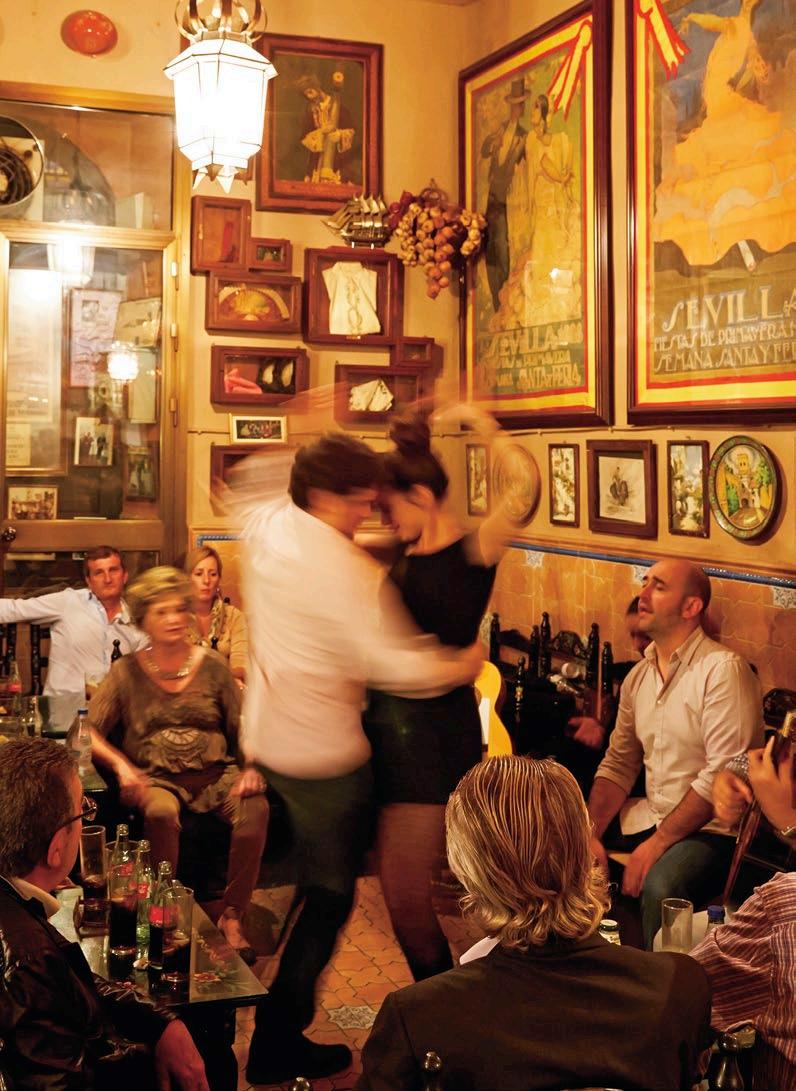 Impromptu flamenco at Casa Anselma in the Triana neighbourhood of Seville; (left) coffee at La Campana
Impromptu flamenco at Casa Anselma in the Triana neighbourhood of Seville; (left) coffee at La Campana
Outside the c O nvent, without thinking, I turn right. At the small Plaza de Pumarejo, in Macarena, a drunk is picking through the trash. A few feet away, a man has an easel propped up and is painting the church. I pass a fruit stand, a vintage clothing store, a hat shop. By the Almohad walls, which date from the 13th century, I walk into the basilica. There’s a wedding taking place. I turn to leave, then turn back. There she is, above the altar. Her head encircled in gold filigree; her cloak encrusted with jewels; on her cheeks, crystal tears—the weeping Virgin.
Twenty years ago I passed through Seville for one night. A few random images have lingered in my mind: a dark, narrow lane late at night that gave way to a tiny, jasmine-scented piazza; a young woman hitching up her long skirt to dance an impromptu flamenco in a crowded bar. And a photo on a restaurant wall of a statue of the Virgin Mary with tear-stained cheeks. Lured by these mental postcards, I’ve come back for a closer look.
Situated in the fertile Guadalquivir River valley, around 300 miles southwest of Madrid, Seville is the capital of Andalusia, with a population of 700,000. Though its history dates back to Roman times, a Moor invasion in the eighth century left a cultural imprint that largely defines the city today. A few centuries later the Christian reconquest gave the city its massive cathedral; by the 1500s, Seville was the centre of trade with the New World.
But when silt began to clog the river and shipping moved south to Cádiz, the city lost much of its clout. Thanks in large part to the creation of places such as architect Aníbal González’s Plaza de España, for the 1929 IberoAmerican Expo, Seville began its long road back to cultural relevancy. The centre of town today is a jumble of ancient, narrow lanes that follow no modern logic, yet Seville is an easy city to settle into.
“Here, it’s all about street living,” says Patrick Reid Mora-Figueroa, who runs the Corral del Rey, a boutique hotel in a restored 17th-century palace, with his brother Anthony. “Very little entertainment happens in the home in Seville. But try to get a party to leave their table at a restaurant in less than three hours, forget it.”
While many corporate businesses maintain conventional working hours, the daily rhythm of life in Seville— most of its shopping and dining— still carries on in the old ways. A late lunch is followed by an afternoon siesta, when most businesses shutter. Life kick-starts again after 9pm, when people take to the streets, often for a tapas crawl.
On one cloudless night, I start at El Rinconcillo, said to be the oldest tavern in Seville, dating from 1670. Ornate Moorish tiles climb the walls, wooden casks hold the wine. Beside me, old men sip sherry. Overhead, legs of the famous jamón ibérico hang from the ceiling. A waiter in white shirt and
O pho T o S , p REVI o US S p READ AND oppo SITE: ©ch RIST oph ER TESTANI | 01•2015 98 S l EE pl ESS IN SEVI ll E
 The Seville Cathedral bell tower was the minaret of a mosque that once stood on the site
The Seville Cathedral bell tower was the minaret of a mosque that once stood on the site
black vest slices paper-thin slivers of the sweet, potent cured ham—Spain’s answer to prosciutto. He deposits each slice with reverence on a small white plate, then another similarly clad waiter shoves the platter in front of me. A third waiter whips a piece of chalk from his pocket and scribbles the price directly onto the wooden bar in front of me, adding it to my running tab. This is as old-school as it gets.
Behind the bar is a photo of a statue of the Virgin Mary weeping. It’s the same image I saw so many years ago. It turns out that Our Lady of Hope, a.k.a. La Macarena, is beloved throughout Seville. The statue is paraded in the streets each year during Holy Week, before Easter. I will see her photo in what seems like every restaurant and shop in Seville.
A few minutes’ walk away, just off the tiny Plaza de San Lorenzo, I find the other end of the tapas spectrum. Espacio Eslava, a hip, modern joint, draws a smart urban crowd that overflows onto a narrow street. Pepe Suárez leads a happy staff behind the swarming bar.
“The tourists come early; the locals come late,” he says, delivering the house specialty, huevo sobre bizcocho de boletus (slow-cooked egg on boletus cake with a wine reduction). After another of those, then a green pepper stuffed with hake, then scallop over seaweed purée and kataifi noodles, I head to the nearby Bodega Dos de Mayo, where tables are spread out on
the dimly lit Plaza de la Gavidia. The women smoke, the men sip glasses of beer and the kids race beneath orange trees. In the shadows, a solitary old man plays a violin. Beside him is a large poster of a woman in a long red dress, castanets in hand.
Images of flamenco, the dance born in Andalusia, are everywhere. Redand-white dresses with frilling trains fill shop windows; advertisements for shows are plastered on walls. The music and dance are often dismissed as a tourist enticement yet there are many neighbourhood bars where the locals dance the sevillana, an erotic form of the dance done in pairs.
Long hair pulled back, piercing eyes, arms flung toward the heavens, feet stamping down—if people unfamiliar with flamenco hold an image of the dance in their minds, it’s probably one of legendary local dancer Cristina Hoyos. Together with Antonio Gades, she helped bring flamenco to the world beginning in the late 1960s.
“It’s not necessary to understand flamenco,” she tells me, sitting among the displays of her flamenco museum. “It must be felt.” The long black hair has gone an equally dramatic silver, and her eyes are still the mix of coy, flirtatious mischief and fiery resolve that captures the essence of flamenco. “In flamenco there is all of life. The joy, the sorrow. And it belongs to Andalusia, to Seville,” Hoyos declares. “It was here long before tourism, and it will be here after.”
| 01•2015 100 S l EE pl ESS IN SEVI ll E
Across the river, in the working-class neighbourhood of Triana, is where most of the local flamenco clubs lurk. In a shopfront bar called Lo Nuestro, a guitarist strums a ferocious beat as a bartender unabashedly belts out a plaintive ballad to an empty room. By 3am the guitar is even more insistent, the bartender is too busy to sing, and the crowd is clapping and stomping along. Next door, couples are swirling in a passionate sevillana. A few blocks away at Casa Anselma, an impromptu session has broken out in a sweaty room beneath antique flamenco posters and…the weeping Virgin.
nO where in s eville is the dramatic commingling of life’s suffering and glory more on display than at las corridas, or bullfights. It’s easy —and perhaps correct—to decry bullfighting as barbaric. But to grasp Seville, you must at least make an effort to come to terms with what los toros mean to Sevillanos.

Street dining in the Santa Cruz district, near Seville Cathedral
evenings throughout much of the year, the local population gravitates towards the Plaza de Toros de la Real Maestranza de Caballería, on the banks of the Canal de Alfonso XIII.
“It’s part of us. It’s inside us,” Cristina Vega tells me from her family’s sombrerería on Calle Sierpes, the city’s pedestrian-only main shopping thoroughfare. “It would be a great loss for us if bullfighting were no more.”
It’s a sentiment I hear often around town. At festival times and on scattered pho
Before entering, the spectators at nearby bars buzz in anticipation. A working-class crowd spills out onto Calle Adriano from Cafe-Bar Taquilla. Beer and excited chatter flow freely beneath the framed black-and-white photos of legendary bulls and famous toreros. On the way to his first bullfight, a young boy, no more than five, stands on a stool at a tapas bar beside his father. Around the corner, a more
01•2015 | 101
T o: ©Joh N B ANA g AN /g ETT y I m A g ES
upscale crowd crushes elbows at Bodeguita A Romero.
Once the 14,000 are packed inside, three young bullfighters making early professional outings will each fight a pair of bulls. The evening lacks the polish I’ve seen with more experienced bullfighters, but the notoriously demanding crowd is generous and appreciative of the novices.
Before his second bull, Juan Solís, 22, a local boy who looks about 16, doffs his montera to the crowd and walks to the edge of the ring. He leans over the wall and dedicates this bull to an older man in the first row I assume to be his father or a mentor. Young
Solís offers the cap, with solemnity, to the man. Tears pour down the older man’s cheeks as the boy with the red cape struts towards the heaving animal in the centre of the dirt ring, sword in hand. Bullfighting may have become a dying relic in many places—including parts of Spain—but on this night in Seville, it’s deeply personal and alive.
like all places Of real interest, Seville thrives on its contradictions. It can seem like a small town, yet I get lost along the narrow lanes. It has a strong Catholic legacy, but so much of the city’s architecture and feel is decidedly Moorish. Restaurants such
trAvel tips
n Dining:
Bodeguita A Romero, 19 calle Antonia Díaz, offers rabo de toro (oxtail) and piripi (Seville’s answer to the BlT), €25–€75 (+34 954 223 939).
Casa Anselma, 49 calle pages, del corro, has dining and flamenco dancing, €20–€60. ConTenedor, 50 calle San luis, has embraced the Slow Food philosophy,
€20–€60 (contenedor cultural.com).
n SightSeeing:
Basilica de la Macarena, 1 calle de Bécquer, (herman daddelamacarena.es).
Monasterio de Santa
Paula, 11 calle Santa paula (santapaula.es).
Museo del Baile
Flamenco, 3 calle manuel Rojas marcos (museoflamenco.com). Plaza de Toros de
La Maestranza de Caballería, paseo de cristóbal colón (realmaestranza.com).
n LoDging:
Corral del Rey, 7 & 12 calle, corral del Rey, a boutique hotel, €280–€600 (corraldelrey.com).
Hotel Alfonso XIII, 2 San Fernando, is a grande dame in the city centre, €285–€400 (luxurycollection.com).
| 01•2015 102 S l EE pl ESS IN SEVI ll E
as Nikkei Bar, serving Japanese-Peruvian fusion, and ConTenedor, with its retro, urban-hipster vibe, are bringing new life, but nearby at the Monasterio de Santa Paula things are still rooted in the past.
I lift the old bronze knocker and let it fall against the heavy wooden door. After a few minutes it creaks open and a heavily creased nun in full habit inspects the intruder. I’ve been told that the sisters make a sweet marmalade; I say as much. The nun silently admits me. In a spartan, woodpanelled room she reaches under the counter and produces a small jar.

I gravitate without conscious thought to the Basilica de la Macarena. And while a young couple kneels before a priest to be married at the altar, I’m confronted with the weeping Virgin above the tabernacle. Strangely, it never occurred to me to seek out the statue —which speaks perhaps to the ethereal presence the image has occupied in my mind. Yet encountering her now, excitement and comfort, surprise and relief, delight and wonder all mingle.
“Three euro, eighty,” she tells me.
I hand her a five-euro note. The bill disappears under her garment; she offers me no change.
It’s then, outside the convent, that
Maybe these feelings are elicited by the cavernous, ornate church; after all, these are among the sensations religion endeavors to evoke. But perhaps it’s something else entirely. My passions, it occurs to me, stem from finally having kept my long-held date—with Seville.
A criminal cut out the hard graft for detectives when he sat on his phone and called the police with his bum. The recorded line captured the man discussing his plans to follow and kill another man, who was murdered minutes later. “criminals say crazy things all the time,” said a spokesman, “but I’ve never seen anyone call a recorded line.” seen on newser.coM
pho T o: ©ch RIST oph ER TESTANI 01•2015 | 103 r e A der’s d igest
copy RI gh T © 2014 By A NDRE w m ccART hy. Travel & l eisure (AU g UST 2014). TRAVE l AND l EISURE .com
The weeping Virgin in Basilica de la Macarena A cheeky tip-off
FOR MORE, GO TO reAdersdigest.co.uk/trAvel-Adventure
Are you getting the right advice?

EXPERT, INDEPENDENT ADVICE SEEMS TO BE TAKING A BACK SE AT TO INSTANT ONLINE INSURANCE, and we aren’t certain that consumers are getting the advice they need in order to choose the insurance cover that’s right for them. Most online insurance packages aren’t speci c to the individual consumer—they generally provide set limits of cover and if those don’t match your requirements then the policy may not be suitable.
All insurance policies contain exclusions and conditions. When you deal direct or online, the onus
ADVERTISEMENT FEATURE
is on you to understand these and make sure they don’t a ect your cover. Most online quotations rely on a series of assumptions to calculate your premium—if any of these assumptions is later found to be inaccurate, any claim you try to make could be turned down.
If you choose to deal direct with an insurer and need to make a claim, who do you turn to for independent support and advice if the insurance company’s settlement gure isn’t acceptable to you or if the claim isn’t being handled satisfactorily?
THE SOLUTION
We believe in expert quality advice. From home insurance to travel insurance, we all have individual requirements, and Reader’s Digest is delighted to announce a range of insurance services that will provide the advice and cover YOU need at a price that might surprise you.
We’ve teamed up with Higos to launch Reader’s Digest Insurance

Services to o er a range of quality advice-led services. Higos have been providing personal advice and insurance to their customers for 25 years and they have the interests of their customers rmly at their core.
Over the coming months, we will launch a range of products from home and motor insurance to pet and personal accident. But since winter is the time that most people start planning their next holiday, we thought we’d start with Travel Insurance.
“No two enquiries are ever the same,” says Reader’s Digest Insurance Service’s Richard White. “ e individuals contacting us are generally very excited about planning their travels and realise the importance of having insurance that will meet their speci c needs. e travel insurance we o er is as wide and varied as the travel requirements of our customers and includes cover for existing medical conditions with no upper age limits.”
TO GET IN TOUCH, call 020 8069 3102 (local rate) for a quotation or 020 8069 3100 (local rate) for no obligation advice. Or visit www.readersdigest.co.uk/money/insurance for further information.
Arranging Your Financial Calendar
Being prepared in advance for these events can help to improve your cash flow

Nick Hill is a money expert at the Money Advice Service. Visit money adviceservice. org.uk for details

this YEar is gOiNg tO sEE sOME big chaNgEs to what money you have and how much you spend. Some will need to act fast, while others should wait and see. Here are some key dates you need to mark in your diary.
JaNuarY train-fare increases
As of January 2, fares will rise by 2%. That means if you commute by rail with a season ticket you’ve got until January 1 to beat the increase and buy at 2014 prices. Starting your season ticket before then can mean a big saving.
March general-election promises
Any election year will see a raft of pledges from political parties. You can expect this year’s budget in March to have big economic policy announcements as the Government looks to attract voters. Exactly what will happen and when won’t become clear until later, but you can be sure that taxes and benefits will be hot topics.
april pension changes and isa deadlines
The start of the month sees some of the biggest changes in how pensions work for generations. If you’re about to retire, waiting until April could offer some massive financial advantages. Over 55s will be able to take up to a quarter of their pension pot tax free, convert some or all of the rest into a guaranteed taxable income for life (an annuity), or withdraw the remaining cash in stages or as
| 01•2015 106 MONEY
I
B
bY N ick hill Illustrat
on
y
Dan MItchell

one lump sum. Tax still needs to be paid on either option, as if it were income. To help you decide, you’ll also be able to get free and impartial guidance.
Last summer, ISAs were boosted so you could get tax-free interest on savings up to £15,000 a year, rather than just under £6,000. You’ve got until April 5 to pay in up to that amount. If you have the savings, filling the year’s allowance can make a big difference. Then from April 6 you can open a new ISA—also known as a NISA—and start again.
MYstErY datE interest-rate rises
The base rate has been at 0.5% for nearly six years now, but we could see a move towards what Bank of England governor
Mark Carney calls a “new normal” of around 2.5 to 3%. When the Money Advice Service researched how interestrate rises would affect home-owners, it found 47% of people would find a rise of £150 a month hard to cover. Almost one in five would really struggle to cover any increases.
Any rise could be as gradual and as little as a quarter or half per cent each time, or there could be percentage-point increases. You’ve probably got time to find out what you can afford and make changes to your spending and saving before it becomes unmanageable (see p109). Interest rates on savings will rise too, but don’t expect significant changes for a while yet.
01•2015 | 107
Four Steps To OnKeep Top Of Your Cash
The New Year is always when we start to think about change. An expensive festive season—combined with that promise to start again and do better in the coming 12 months—means money is often top of the resolution list. Try these tips to help you manage your money throughout the year and avoid getting into difficulties.
1. start a budg
This will show what money you have coming in, what money is going out, and most importantly, how much you have left at the end. It’s not as scary as it sounds as there are many tools and templates that can help you, including one on the Money Advice Service website.
2. saVE FOr EME
Research shows that 70% of households face an unexpected cost in a year. If you manage to put aside just £3 every day into an emergency fund, you most likely won’t get derailed by a broken boiler or high vet bills.
3. idENtiFY siMplE cutbacks
Even just having one less shopbought coffee a week can save you over £150 over the course of a year. You’ll find there are plenty of small ways that can quickly add up. The cutback calculator on the Money Advice Service website can help here.
4. paY OFF dEbts rathEr thaN haVE saViNgs
If you have debts but are also putting money into savings, you’re usually far better off using that money to clear what you owe—the interest rate you’ll be paying on the debt is likely to be far higher than what you’ll be making

| 01•2015 108 M oney
Anticipating Interest Rates
What can homeowners do now about possible interest-rate rises?
FiNd Out hOw Much EXtra
YOu’ll bE paYiNg
It’s impossible to know exactly when a change will happen and by how much, but you can check online what a 2.5% increase would mean to you and decide if you need to cut back
thiNk abOut OVErpaYiNg
If you have some savings, it’s worth seeing if you can make any overpayments to your mortgage, either in a lump sum or just by increasing the monthly payments. Overpaying £100 a month on a £120,000, 25-year mortgage charging 4% will save you
£15,000 in interest payments. It’ll also shave five years off your mortgage, clearing it in just 20 years.
But there are reasons why it’s not always the best option, so check your terms and conditions.
EXplOrE a NEw MOrtgagE dEal
If your deal is coming to an end, the earlier you prepare the better. You can look into a new mortgage deal to see if you can take advantage of current rates. For certainty, you could lock into a rate with a fix, or you could stick with a variable if that works out more cost-effective. You may have to move lenders to get the best deal, which means you might need an affordability assessment.
If your home value has increased, your loan-to-value (LTV) ratio may also have increased. This could mean you can choose from more lenders and lower rates.
did YOu kNOw?
a hEalthY rElatiONship with cash
Money habits are formed by the age of seven, so get your children and grandchildren involved with spending and saving early.
takE actiON
online tax returns for 2013/14 are due by January 31. It’s also your last chance to pay any tax you owe and avoid a penalty.
tErMs EXplaiNEd
BoGoF (Buy one Get one Free). this is an offer you’ll often see on supermarket shelves. Make sure you actually need the extra item and check the sell-by-date.

01•2015 | 109 rE ad E r’s d ig E st
FOR MORE, GO TO rEadErsdigEst.cO.uk/MONEY
© c lass I c s tock/ a la M y / © shutterstock/Jur I ahMos I n
Easy-to-prepare meals and accompanying drinks
Tumeric and Pea Daal
By Rachel walke R

Rachel is a food writer and blogs
at thefoodieat.org
Serves 4
• 750ml water
Di D you know that “flexiterianism” made it into the dictionary last year? It describes the growing number of people who are largely vegetarian, but who won’t refuse the odd bacon sandwich. Even the occasional dabble with vegetarianism is good for the planet—and for your pocket. I eat a meat-free daal every Sunday evening. It’s comforting, cleansing and cheap: the ideal components for a January recipe.
Use the directions below as a launch pad, and don’t be scared to experiment. Lots of daal recipes add a tin of chopped tomatoes to the masala, and I often add mustard seeds and chilli powder as well.
• 250g red split lentils
• 1 tbsp oil
• 1 onion, diced
• 3 cloves of garlic, crushed
• 4 inch piece of ginger, grated
• 2 green finger chillies, thinly sliced
• 2 tsp turmeric
• 1 tsp coriander seeds, ground
• 4 black peppercorns, ground
• 150ml water (for the masala)
• 150g frozen peas, cooked according to instructions
• 1/2 lemon, cut into wedges
• Optional serve: chapatis
1. Bring the water to the boil. Thoroughly rinse the lentils under a cold tap and tip them into the water. Put the lid on the pan and allow it to
| 01•2015 110 food & d Rink
photographed by t im & Zoë h ill

gently bubble away for 30 minutes. Then leave it to rest with the lid on.
2. Meanwhile, prepare the onion, garlic, ginger and chillies.
3. Heat the oil in a separate pan and cook the onions until softened. Add the garlic, ginger and chillies. Stir in the turmeric, ground coriander and ground peppercorns to create a masala. Pour the 150ml water over the masala and cook for ten minutes.
4. Take the lid off the pan of lentils and use a fork to whisk to a fluffy consistency. Add the masala and the cooked peas to the lentils, and stir until combined. Serve with some lemon wedges and chapatis.
Ideal drink for the dish
■ Blow Horn Cider
The Drink Shop, £2.81 Blow Horn Cider, made by the Cotswold Cider Company, has been developed especially to partner Indian food. The spiced cider is laced with cinnamon, clove and cardamom notes, making it a great accompaniment to a daal or curry. Drink chilled or with ice.

01•2015 | | 111
Vegging Out With A Beer
o n the subject of meat-free eating, did you know that some strict vegetarians will refuse certain beers because they contain isinglass, which comes from a sturgeon fish’s swim bladder? Once dried and pressed, isinglass is often added to cask ales, where it helps settle and clarify the sediment to create a nice, bright beer.
The Food Standard Agency lists isinglass as an exempt ingredient, so it doesn’t need to be listed on labels. This can make things a bit of a minefield, but websites like vegsocapproved.com and barnivore.com have a database of vegan and veggie beers, and lots of companies, such as

Guinness, are very open about their beers containing isinglass. There are also lots of vegetarian-friendly beers making their voices heard.
The Black Sheep Brewery, Black Isle Brewery Co and The Marble Brewery are all safe bets. They do a good line in pale ales, blondes or pilsners, which are all good accompaniments to a daal or curry. Indian-style lagers, Kingfisher and Cobra, are also classic choices—and are vegan-friendly too.


■ Black Sheep Ale
The Black Sheep Brewery, £1.99/500ml at ocado
■ Black Isle Brewing Co
Blonde £1.80/330ml in their online shop
■ Cobra £1.99/660ml at Tesco
fiShy facTS aBouT BeeR
■ English brewers started adding isinglass to beer in the 16th century, when dutch traders brought it over from russia. it’s thought that the discovery was first made when medieval brewers used dried bladders as a vessel, and noticed that the beer was much clearer and brighter when poured from a sturgeon’s bladder above anything else.
■ isinglass finings work by attracting the fine yeast particles floating in the beer, until they are so heavy they sink to the bottom—clarifying the beer.
| 01•2015 112 Food & d rink
Pudding of the Month

Cheat’s Kulfi
Traditional Indian puddings are an acquired taste, even for those with the sweetest tooth. Kulfi is a creamy-dense ice cream, but when delicately flavoured with saffron it makes for a sophisticated end to a meal, with minimal effort.
An authentic kulfi is made in a cone-shaped mould, but it tastes just as good made in a tub. Use crushed pistachios for a traditional topping, though I find that the astringent-saffron flavours are delicious with a spoonful of berry compote.
Serves 4
• 300ml full-fat milk
• 1 generous pinch of saffron
• 397g tin condensed milk
• Optional serve: crushed pistachio nuts
1. Heat the milk in a pan and add the saffron.
2. When the milk is near-simmering, stir in the condensed milk.
3. Pour into four moulds or dishes and freeze.

Deliciously Ella by ella woodward, £13.60 100 sugar-, gluten- and dairy-free recipes.


waitrose cooks’ ingredient organic ground turmeric, £1.69/50g
Blow-ouT

masterchef travel india trip A ten-day long gastronomic tour round Kerala, from £1,995pp.
Reade R ’s d igest 01•2015 | | 113 © d orling k ind E rsl E y ltd/Al A my / © shutt E rstock/ E l E n A mois EE v A / photo court E sy o F mA st E r c h EF t r A v E l
Book
FOR MORE, GO TO ReaDeRSDiGeST.co.uk/fooD-DRiNk
BaRGaiN
BY ALISOn CORK






Home and interiors expert
Alison Cork runs luxury furniture and accessories brands alison athome.com and homeware clearance site oneregentplace. co.uk
Considering Colours
alison answers your questions on getting your home’s hues just right
QI’m looking for a timeless piece to anchor my constantly changing living-room style. What’s a classic must-have that will remain trendy?
AA neutral coloured, comfortable and high-quality sofa should never be overlooked when refreshing a living room. Not only will they go with any decor you introduce, but they will provide you with years of use if carefully selected.
It’s important to be fussy when investing in a sofa, and cheap woods and materials simply won’t cut it. Opt for hardwood frames made from oak, ash or beech, and ensure the legs are held to the frame with screws or dowels. Though it may be tempting to choose a wild colour, it’s best to go with more neutral tones that will give you more freedom when decorating.
Gardeners’ Diary
With dark nights and plummeting temperatures, winter may be an ideal time for hibernation. But it also offers a chance to take care of a few odd gardening jobs.
■ Shred your Christmas tree for mulch.
■ Get moving on any landscaping plans while the garden is already muddy.
■ Plan your crop rotation for the upcoming season.

| 01•2015 114 hOmE & GARDEn
© ShuTTerSToCK/euroBanKS

QI want to repaint my living room with a bold new colour but I’m terrified it won’t work in the space. How do I know that I’m making the right choice?
AThe old saying “try before you buy” couldn’t be more relevant when it comes to choosing paint. The architecture, shape and light of a room can contribute greatly to how paint appears. Once you’ve decided on a few shades, pick up some samples to paint onto a card or get hold of some nice swatches to hold against your current wall. Test these samples throughout the day to check how they appear against changing light.

OVERnIGhT UPDATE
Whether you’re refreshing the look of your living room with a few new additions or undergoing a full renovation, these practical tips will make the process a breeze.
Stack up
Pile books of different sizes on top of one another either on your coffee table or in a basket on the floor to create an intriguing makeshift end table. This look can be achieved with magazines, novels and coffee-table books, or a mixture of all.
The golden rule


Balance out the depth and mood of dark walls by using gold accessories and natural wood for a more homely feel. These lighter tones will add warmth to any room. Mosaic Gold Frame, £22, styleandlight.com
mix materials
Complement sleek cushions and lush fabrics by filling your living room with a unique blend of materials. from wire and brass to cork and glass, these various textures and colours will give your room real personality.
01•2015 | 115
© medium Colour BooK, farroW & Ball / © dunelm / © ShuTTerSToCK/lindSaY BaSSon
Get the Look: A Modern Take On The Classics
update your period living room by introducing industrial-style pieces anchored by an opulent wall colour and Chesterfield sofa






1. Retro Moustache Cushion, £37, greatbritish-designs.co.uk
2. Mayfair Dark No. 218, £34.66 (2.5L), mylands.co.uk
3. Revival Churchill Parquet table, £449, houseoffraser.co.uk
4. Distressed Wire Basket, £7.95, onebrowncow.co.uk
5. Branagh Chesterfield Sofa, £999, made.com
| 01•2015 116 home & Garden © r evival l ivin G r oom SS14, h ou S e of f ra S er
1 2 3 4 5 FOR MORE, GO TO READERSDIGEST.CO.UK/hOmE-GARDEn

Bring Your Old Speakers To Life
By olly mann

Olly is a technology expert, LBC presenter and Answer Me
This!
podcaster
The Vamp, £59.99
Bluetooth speakers and iPod docks are stylish, but frankly you may already have superior speakers from previous decades lying around your house, connected to old record players and hi-fi systems. Plug this brilliant little box of tricks into any speaker featuring the traditional red and black wires, and it becomes a Bluetooth-enabled, battery-powered, portable boombox, to which you can stream music from any smartphone or tablet. The sound may be mono, but the thrill of giving new life to dusty equipment is dynamic indeed.


android app
of The monTh:
ScouT, free
This sat-nav app, formerly known as Skobbler, claims to be the first free “premium” navigation app—though I suspect Google Maps may have something to say about that! Where it has the edge,

though, is the public can volunteer updates, such as adding pedestrian trails. In theory that makes it more accurate than others, but also more vulnerable to pranksters or clumsy contributors. Of course, now it’s free, you can suck it and see.
| 01•2015 118 Technology
SamSunG Galaxy noTe 4, £629 (or on conTracT)
Back in 2011, when Samsung launched their original Note “phablet” (half phone, half tablet), tech journalists laughed. At 5.3 inches, it was surely too large to ever hold up to your face to make a call? And a built-in stylus! What was the point of that? Sixty million sales later, with the trend for larger phones well established, the Note 4 is getting rather more respect. Which is as it should be: the metal chassis is classy, the audio crisp and the 5.7-inch Super AMOLED screen is the most dazzling, pin-sharp phone display I’ve seen. The S-Pen, with which you handwrite notes on your screen, remains an acquired taste, but a neat trick. reSponSe faKeTV, £24.99

Winter is the peak time for burglaries in the UK, and thieves often set their sights on empty homes. Some people have taken to leaving their TVs switched on when they go out in an attempt to deter trespassers, but this is a drain on energy bills. This tube of flashing LED bulbs sucks up less power than a night-light, yet creates the same visual deterrent as a 27-inch TV. The series of unpredictable light and colour patterns it produces, viewed through closed curtains, mimic exactly those of a telly being viewed.


ViVino Wine Scanner, free
A sort of TripAdvisor for wine, this app allows you to take a snap of a wine and provides a history, average price and how it rates among fellow Vivino users. Invaluable advice if you’re assessing which wine to order in a restaurant, or are caught between two similarly priced bottles in the supermarket.

FOR MORE, GO TO readerSdiGeST.co.uK/TechnoloGy
apple app of The monTh
01•2015 | 119
By Geor G ina yates

Georgina is a fashion and beauty editor for numerous travel titles and a blogger at cargocollective. com/withgeorgia
Getting Lippy

IT’S BEEN SAID THAT RED LIPSTICK is all “about female strength,” and looking back, its impact on society has been significant.
In 1770, Government passed a law stating “women found guilty of seducing men into matrimony by cosmetic means” will be tried for witchcraft. At this time, lipstick was only worn by theatre performers and prostitutes, and it wasn’t until the early 20th century that it began to be introduced into society.
French actress Sarah Bernhardt challenged the norm by wearing her red lipstick off the stage, and in 1912 Elizabeth Arden supplied the Suffragettes with red lipstick, claiming
Shear Elegance
Shearling returns to the high street this winter. Here are our top three ways to incorporate this cold-weather accoutrement into your winter wardrobe:
1. Wear this knitted sheepskin gilet from Jigsaw (£350; jigsaw-online.com) over a plain polo neck and trousers for an elegant look.
2. This tan, faux-shearling coat from Topshop (£78; topshop.com) is a subtle way to incorporate the winter trend.

3. Be practical and stylish in these cosy, purley lined leather ankle boots by Bertie (£108; johnlewis.com).


| 01•2015 120
Fashion & B eauty

every woman had the right to take pride in her appearance. With the outbreak of the Second World War, red lipstick was seen as a necessary cosmetic for the morale of the female workforce, and shades were even given names such as “Fighting Red!”
Lieutenant Colonel Mervin Willett Gonin, one of the first British officers to liberate the Nazi death camp BergenBelsen, famously recorded the effect that the arrival of a batch of red lippy had on the female inmates of the camp: “I believe nothing did more for these internees than the lipstick. At last someone had done something to make them individuals again… That lipstick started to give them back their humanity.”


• Elizabeth Arden’s Beautiful Colour Moisturising Lipstick in Power Red (£20; houseoffraser.co.uk).
• Estée Lauder’s Pure Colour Envy Sculpting Lipstick in Red Ego (£24; debenhams.com).
• M.A.C’s Lipstick in Damn Glamorous (£15.50; maccosmetics.co.uk).
hand savers
Cleopatra was said to bathe in milk to keep her skin supple, but for us everyday folk with chapped hands, an off-the-shelf moisturiser will just have to do!
L’occitane’s shea Butter hand Cream (£19; uk.loccitane.com) harnesses the power of shea butter—used for centuries by women from Sub-Saharan Africa to soften skin.
Beeswax & Banana hand Crème from Burt’s Bees (£9.99; burtsbees.co.uk) is a natural product, that works wonders overnight.


Balmy Days
Beat chapped lips with Origins’ Dr Andrew Weil for Origins Conditioning Lip Balm with Turmeric (£16; origins.co.uk).
I love how it tingles when applied, and its longlasting, soothing effect means it needn’t be constantly reapplied— great for wearing under your lipstick.

01•2015 | | 121
© Gl ASS hou S e Im AG e S /Al A my
ACraftBewitching
g REEK my THOLO gy, femme fatales and the art-deco movement all play their part in inspiring the striking collections from jewellery designer Cara Tonkin. Based in Brighton, Cara first fell in love with this craft while studying


fashion & beauty

RAYMOND GUBBAY and the ROYAL ALBERT HALL present THE SPECTACULAR ‘IN-THE-ROUND’ PRODUCTION STAGED IN AN ENCHANTING JAPANESE WATER GARDEN
THE EAGERLY AWAITED RETURN OF THIS ACCLAIMED SELL OUT PRODUCTION



Box
Book
. .
SUNDAY TIMES
supported by
ROYAL ALBERT HALL 26 February - 15 March
Office 020 7838 3100
online royalalberthall.com
‘.
ravishingly designed’
‘epic staging’ EVENING STANDARD
SPECIAL TICKET OFFER - SAVE £10.00 ON SELECTED PERFORMANCES
5, 10,
applies to selected stalls, front choir and front circle seats only and excludes
other
Tickets
card han dling fee
of total transaction)
all telephone or online bookings.
Book your seats before 20 February and you can save £10.00 per ticket on selected performances. Offer Valid on: 5, 10, 11, 13 March Standard Tickets £71.86 £48.40 £42.28 * OFFER PRICE £61.66 £38.20 £32.08 * Call 020 7838 3100 quoting ‘Readers Digest Offer’ or online royalalberthall.com and enter 18244 when prompted. Conditions: This offer is subject to availability, does not apply to tickets already purchased and cannot be used in conjunction with any other offer or discount. Offer closes 20 February 2015. Offer valid on performances on 3,4,
11, 13 March only and all other performances are excluded. Offer
all
ticket prices.
cannot be exchanged or refunded. * Prices include a transaction processing fee (£2.50 per ticket) and
(2%
on
books
A gripping thriller to rival Gone Girl and an historical novel heading for the small screen
January Fiction
b y J AME s

James writes and presents the BBC Radio
4 literary quiz The Write Stuff
The Girl on the Train
by Paula Hawkins
(Doubleday, £12.99; ebook, £6.02)
This isn’t a huge claim since it’s only January, but The Girl on the Train may be the most hyped book of 2015 so far, with several people talking of it as this year’s Gone Girl . It’s also tricky to review because the narrative twists begin almost straight away, and to give away even the early ones would deprive readers of several satisfying shocks.

What I can reveal is that, on her morning commute to London, a woman called Rachel becomes mildly obsessed with a couple whose garden she can see into when the train is at a red signal. But then she spots something that suggests their lives aren’t as idyllic as she’d imagined…
From there we enter the kind of thriller you can’t put down, even when your own train journey ends and you’re walking along the platform. Looking back afterwards, you may wonder if everything was as plausible as it felt at the time. Yet, when you’re actually reading it, you’re far too swept along to care.
NAME THE AUTHoR
(Answer on p128)
Can you guess the writer from these clues (and, of course, the fewer you need the better)?
1. This year marks the 50th anniversary of his death.
2. He wrote a winner of the Nobel Prize for Literature, which has been the basis of a successful Andrew Lloyd Webber musical.
3. His name is an anagram of the word “toilets”.
| 01•2015 124
WA lT o N

KBO: The Churchill Secret
by Jonathan Smith (Abacus, £8.99; ebook, £4.99)
In the summer of 1953, all seemed well in Britain. Everest had been conquered, the Queen crowned and the Ashes regained. What few people realised, however, was that the country was effectively leaderless. In June, prime minister Winston Churchill had suffered a stroke that left him unable to walk or talk. Among those who did know, his wife Clementine was desperately hoping that Churchill would now take the hint and retire— and so, for different reasons, was his anointed successor Anthony Eden. But not for nothing was Churchill’s motto KBO, or Keep Buggering On. By the autumn, he was delighting the party conference with a barnstorming declaration of his determination to continue in office. This is clearly a great story (already snapped up for a “major drama”) and Jonathan Smith tells it with the right blend of imagination and research. Admittedly, his writing is solid rather than scintillating, and while he’s aware that Churchill’s courage was closely tied to his egocentricity, his admiration for the great man sometimes becomes a little too obvious. Even so, this is both a fascinating slice of history and a stirring read.
NEW-yEAR pApERbAcks
■ January Window by philip kerr (Head of Zeus, £7.99). Experienced thriller writer with a whodunit set in the strange world of the Premier League.
■ Wives and Sweethearts by Alastair Massie and Frances parton (simon & schuster, £7.99). Selection of love letters from both world wars, with the background stories supplied.
■ A Bit of Difference by sefi Atta (Fourth Estate, £8.99). A moving, fearless and often witty novel about a Nigerian woman in London caught between two worlds.
■ Who is Tom Ditto? by Danny Wallace (Ebury, £7.99). A newsreader is forced to reassess his life when his girlfriend leaves him. Sharp and entertaining lad-lit.
■ Four Sisters: The Lost Lives of the Romanov Grand Duchesses by Helen Rappaport (pan, £8.99). Intimate account of the Tsar’s daughters, killed by the Bolsheviks in 1918—with Rasputin as darkly enthralling as ever.

01•2015 | | 125
© K A r L Bu LLA
RD’s REcoMMENDED READ
A tragic set of circumstances lead a young man to discover a whole new life
Unlocking A Secret Past
When he Was in his late teens, Will Boast’s mother died of cancer. His younger brother Rory reacted by taking to drink and drugs, and was himself killed in a car accident a year later. “Broken by grief”, his father “set to the business of drinking himself to death”—a mission he accomplished when Will was 24.
Will
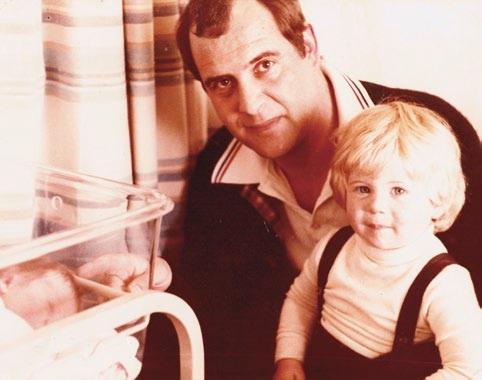
But then, with apparently all of his family dead, Will discovered a shocking secret. He, Rory and their English parents had emigrated to Wisconsin when Will was seven —but it turned out his father had been married before, with two

Epilogue: a Memoir by Will Boast is published by Granta at £12.99; ebook, £6.69
middle-aged sons in Britain whom he’d seemingly disowned.
Put like this, Epilogue might sound rather lurid. In fact, Boast manages to write (and write beautifully) with a combination of great honesty and restraint, noting all his contradictory feelings, noble or otherwise. At one point, he admits that it’s possible “to be proud of grief”. At another, he uses his story to impress a girl.
He’s also very good on being an English boy, as he insists he is, growing up in the American Midwest. (“By 13
© PH o T o C our T esy of W i LL B o A s T | 01•2015 126 B oo K s
and his father with baby Rory
I was a snob. I loathed everything American, fetishised everything English: the BBC, Thomas Hardy, Cumberland sausages, Twiglets, Jaffa Cakes…”) And yet, of course, when he goes to Britain to meet his brothers— and to establish a hesitant sense of kinship—he feels pretty American. Will’s mother and Rory are certainly given their due. The book, though, remains dominated by his once “unbreakable” father: a man he regards with an ever-shifting mix of admiration, exasperation, love and, once the secret is revealed, suspicion.
His stories about his schoolboy days were litanies of brutality. His English master at Bishop Wordsworth’s Church of England Grammar School for Boys was the author William Golding. Golding would later use his dreary tenure there as inspiration and research for Lord of the Flies , conducting social experiments on the boys, pitting them against each other in schoolyard battles. My father and his classmates—who had nicknames like “Knocker” Nokes and “Taff” Thomas—not so affectionately referred to Golding as “Scruff”, because of his scraggly beard. In the island-tight schoolyard hierarchy, my father didn’t fare badly. He was on the boxing team and fought bare-knuckle. By age 13, he was beating even the fifth-form boys; he knew how to take a blow. As for
RD EXclUsiVE:
Will boAsT’s cHoicE oF bEsT MEMoiRs

Don’t Let’s Go to the Dogs Tonight by alexandra Fuller (2002). In Fuller’s account of her southern-African childhood, she encapsulates the tensions of family strife and political upheaval into set pieces that are simultaneously harrowing, uproarious and revealing.
Stop-Time by Frank Conroy (1967). A memoir of childhood so vivid and suffused with experience, it reads like a dream you’re sharing with Conroy.
The Snows of Yesteryear by Gregor von Rezzori (1989). Rezzori’s voice—wry, incisive, perfectly balanced—makes his portraits of family life in the Austro-Hungarian empire —now long gone—indelible.
Essays by George Orwell. Orwell’s honesty and modesty are an example for every nonfiction writer.
The Kiss by Kathryn harrison (1997). Few memoirs touch material as raw and primal as this. It’s written in the most painstaking manner; every sentence feels like a victory.
01•2015 | 127 R EADER ’s Dig E s T
‘‘
a nickname, his classmates called him “Beastie.”
Through his late teens, my father played rugby around Wiltshire, often taking the pitch with men twice his age, men who could only hope to compete by playing dirty. In a scrum,
as if testing fruit at the market. “Oh, you’re all right. Stop whinging and get back in.” Only after they’d won and my father was hobbling off did Doc say in his ear: “Get to hospital, Andrew. You’ve a broken shin.”
A broken shin, a broken foot, a
Dad cracked up whenever he told the story, and so did Rory and I. Even my mother had a thin smile
they’d reach out and grab your balls (“goolies”, my dad would say at this point, his eyes lit with mischief), leaving you howling.
Dirtiest of all was Doc Mitchell, who played for my dad’s club. If a player on the other team went down, however minor the injury, Doc Mitchell would do a quick examination, then send him off, saying, “Have that looked at straight away, lad.” Club teams struggled to field a full side, never mind substitutes. With an injured player, the opposition would have to play one man short.
Once, my dad was sent sprawling by a rough tackle. He went to the touchline, clutching his leg, gasping from the pain. Doc Mitchell huffed his way over and fingered a few bones

AND THE NAME oF
THE AUTH o R is…
T s eliot (the musical is of course Cats).
broken ankle—the injury sometimes changed with the retelling. Yet I knew Dad wasn’t exaggerating. He’d played out that game with an excruciating injury and done so with pride.
The point of the story, I understood, was that showing your pain was a choice, and the choice not to show it required only an exercise of will. How joyous to laugh and play on in the face of pain! Dad thought the story was hilarious, just another in an endless series of boyhood larks. He cracked up whenever he told it, and so did Rory and I. Even my mother had a thin smile.
But now I don’t laugh. I think of his refusal, throughout his life, to see any doctor, not our family GP, not a specialist for his rotten stomach, and certainly not a therapist or a psychologist for his grief-stricken heart. Too proud, too stubborn, too tough, too ashamed to be seen sidelined or entrust anyone else with his suffering.
| 01•2015 128 B oo K s
’’
© L A dy oTT o L i N e Morre LLN AT io NAL Por T r A i T G ALL ery
Books
t H at c H anged M y life

Little House on the Prairie
By Laura
IngaLLs WILder
Jill Mansell’s romantic comedies have sold over seven million copies worldwide. Her 26th novel Three Amazing Things About You is published this month

This was the third of the Little House books, but I loved them all. One of my earliest memories is going to the library on a Saturday, choosing a title from the series and never wanting anyone else to borrow them. I like the stories I read and write to have a happy ending—if I had to write the story of the Titanic, I’d leave out the iceberg.
Riders
By JILLy Cooper
Last year Jilly Cooper sent me a letter, and I couldn’t have been more excited if George Clooney had showed up on my doorstep! In my early teens I avidly read her Sunday Times columns, which my uncle cut out and gave to me. But it was Riders that inspired me to write myself. I grew

up in the Cotswolds, and it was like seeing things from the posh side of society for the first time. I loved the glamorous characters and the fact that it was so much fun to read. I joined an evening class to start on my own career as a novelist soon after.
84, Charing Cross Road
By HeLene Hanff
This is an unconventional love story, less between the two correspondents who exchange letters for 20 years (Helene in New York and Frank at the bookshop in Charing Cross Road in London) than about their shared love of books. I strive to be good like Helene, who sent food parcels from the US to people she had never met in post-war Britain. This is a book that reminds one that, despite all the horrible things in our world, there are so many good people going quietly on with their days. As told to Caroline Hutton

01•2015 | | 129
© Paul Burns
FOR MORE, GO TO readersdIgesT.Co.uK/BooKs
You Couldn’t Make It Up
win £50 for your true, funny stories! Go to readersdigest. co.uk/contact-us or facebook.com/readersdigestuk
DUrinG a Pilates class, our thin teacher apologised to one of the larger members for standing in front of her and blocking her view of herself in the mirror.
“Don’t worry,” the larger lady replied. “I can see myself either side of you.”
amanDa
Barton, Derby
when livinG in new ZealanD years ago, my father worked as a support worker in the police. His job was to follow up non-payment of fines for minor offences. The practice was to send a photocopy of the order for payment to the offender along with a deadline and demand to pay.

i have an aUnt who really strUGGles with new technology— she thinks there’s a “person” in her phone or computer.
One time, the offender thought it would be amusing to reply to the demand by sending a photocopy of a $20 note. On referring the matter to the senior sergeant in charge, my father sent back another demand with a photocopy of a pair of handcuffs.
The offender soon paid up.
roGer Gray, Hertfordshire
Predictive text is a particular sticking point. I was once stuck at the railway station and texted her for a lift. As she’d drunk wine and wasn’t safe to drive, she texted back: “Sorry, I’ve had two glasses of...” and the phone predicted the next word, which popped up as “wine”.
“How did the phone know I drink wine?” she asked.
© steve way | 01•2015 130 FUn & Games
But it really annoyed her when, well into February, she texted: “Did you have a nice....” and the word “Christmas” popped up.
“Doesn’t this person realise that Christmas was over six weeks ago?” was her frustrated retort.
sharon chant, Reading
when markinG some maths tests one evening, I came across a wonderful misunderstanding. In the box labelled “Show your working”, one eight-year-old boy had written: “I’m working really hard.”
Well, you can’t argue with that.
c yoUnG, Leeds
my FoUr-year-olD GranDson was hanging over the garden fence, watching the children play next door.
“I want to go and play with them,” he called.
After explaining to him that he needed an invitation before he could go over, he disappeard upstairs. Five minutes later he ran to me with a piece of paper on which he’d written his name.
“I’ve done it!” he exclaimed. “I’ll give it to them now.”
chistine eDney, East Grinstead
while livinG on a resiDential moorinG, my neighbour Dave often turned his narrow boat around to catch the sun. A canal cat used to visit us, watching for fish and pawing them when he could. Crackers, as the cat
was known, liked to go on Dave’s boat and sleep.
One day, after the boat had been turned to catch the afternoon sun, Dave was clearing up for visitors. He clapped his hands to shoo away Crackers, who leapt out of the bow doors from which he’d entered from the bank. Splash! He wasn’t a great swimmer and had to be fished out with a barge pole and tyre.
After that, he took more care to look before he leaped!
anDrew Graham, Yorkshire
when my twin GranDchilDren Liam and Kayleigh were five years old, I took them for a walk in the woods. It was a windy day, and I started to talk about how wind makes the trees rustle and how it can be used to sail boats and power windmills.
“I know who makes all the wind in the world, Granddad!” said Liam.
I asked him who he thought it was and he replied, “It’s the motherin-law.”
I wasn’t too sure how to deal with this remark because he was very serious about it—at first I questioned what my son-in-law had been saying about my wife. But it soon became clear when his sister burst out laughing and cried, “Liam, you mean Mother Nature. That’s what our teacher told us!”
Once over his embarrassment, Liam soon joined in with the laughter.
Derek thomas, London
r ea D er’s Di G est 01•2015 | 131

it pays to increase your
Word Power
You already know that staying in shape is a key to good health. But keeping your vocabulary finely tuned and toned is just as important. Try this quiz about shapes of the literal sort, then see the next page for answers.
By Emily Cox & H E nry r at H von
1. gangling (’gan-gling) adj
A: loose and lanky. B: bulging with muscles. C: short in stature.
2. helix (’hee-liks) n
A: pointed tip. B: warped outline.
C: spiral.
3. deltoid (’del-toyd) adj
A: triangular. B: circular.
C: squared off.
4. trefoil (’tree-foyl) adj
A: pliable. B: having a three-leaf design. C: tapering narrowly.
5. conical (’koh-nih-kal) adj
A: like an igloo. B: like a cone.
C: like a tunnel.
6. pentacle (’pen-tih-kul) n
A: star. B: crescent moon.
C: square.
7. elliptical (ih-’lip-tih-kul) adj
A: slanted. B: embossed. C: oval.
8. sigmoid (’sig-moyd) adj
A: crossed like an X.
B: curved like a C or an S.
C: bent like an L.
9. whorl (’hworl) n
A: well-rounded muscle.
B: flat surface. C: circular pattern.
10. serrated (’sur-rayt-ed) adj
A: interconnected, as with circles or rings. B: elongated. C: having notched edges.
11. cordate (’kor-dayt) adj
A: string-like. B: heart-shaped.
C: free-form.
12. svelte (’svelt) adj
A: undulating. B: lean. C: in a checked or repeating pattern.
13. zaftig (’zaf-tig) adj
A: pleasingly plump. B: moldable, like putty. C: seedlike, as in an avocado or a peach.
14. lozenge (’loh-zinj) n
A: 90-degree angle. B: level used in architectural design.
C: diamond.
15. ramify (’ra-mi-fiy) v
A: become solid, as cement.
B: jut out. C: split into branches or parts.
01•2015 | | 133
answers
1. gangling [A] loose and lanky. “The protagonist of book The Legend of Sleepy Hollow was the gangling pedagogue.”
2. helix [C] spiral. “Judy is a DNA researcher, so she’s getting a tattoo of a double helix.”
3. deltoid [A] triangular. “The pyramids’ architects obviously knew a thing or two about the stability of deltoid structures.”
4. trefoil [B] having a three-leaf design. “The gardening club uses a trefoil symbol—a gilded clover— as its logo.”
5. conical [B] like a cone. “My favorite conical item? Why, the icecream cone, of course, topped with three scoops of chocolate.”
6. pentacle [A] star. “Hey, this tarot deck is missing all the cards with pentacles!”
7. elliptical [C] oval. “Just two times around the elliptical running track and Rebecca was wiped out.”
8. sigmoid [B] curved like a C or an S. “On Superman’s chest sits a single scarlet sigmoid symbol.”
9. whorl [C] circular pattern. “To find the treasure, take 50 paces east from the tree with the whorl in its trunk.”
10. serrated [C] having notched edges. “ ‘I’m not sure that old serrated knife is best for carving the turkey,’ Dad advised.”
11. cordate [B] heart-shaped. “Sarah is baking cordate biscuits for her cardiologist boyfriend.”
12. svelte [B] lean. “The holidays pose a serious challenge to my svelte frame!”
13. zaftig [A] pleasingly plump. “Known for her zaftig figure, Caroline was a surprising choice for the fashion magazine’s cover.”
14. lozenge [C] diamond. “The boys looked to the sky to see their lozenge-shaped kite flying high.”
word of tHE day*
EsPousE: to adopt or support a cause, belief or way of life.
alternative suggestions:
“a husband or wife acquired over the internet.”
“Half spanish, half Liverpudlian.”
“When you marry your ex-wife again.”
15. ramify [C] split into branches or parts. “ ‘We need to ramify this department to keep productivity high!’ Kerrie announced at the staff meeting.”
voCaBulary ratings
9 & below: obtuse 10–12: Well-rounded 13–15: Full circle
Word Po W er | 01•2015 134
*POST YOUR DEFINITIONS EVERY DAY AT faCEBooK.Com/rEadErsdigEstuK
20% OFF exclusively for you!
The Reader’s Digest online shop has had a makeover and now o ers an even richer range of entertainment and lifestyle products. From bestsellers and literary classics to new and favourite films and TV shows we o er the best choice of DVDs, Books and CDs too. We’re continually adding new shop items to improve your health and wellbeing and fill your leisure time. We even have a range of innovations you and your pets will appreciate!

Take advantage of our exclusive o er and visit our new look shop. Simply add the code: the order form when you complete your order and 20% will be deducted from the total.
RDS005 to

Why not log on now and have a browse!







shop.readersdigest.co.uk
NEW WEBSITE
BrainTeasers
Challenge yourself by solving these puzzles and mind stretchers, then check your answers on page 139.
at home Can you spot the seven differences between these two pictures?

cubed When the shape on the right is folded to form a cube, which is the only one of the following that cannot be produced?
in sequence
Which number comes next?
| 01•2015 136
a d e 10, 1, 8, 3, 6, 5, ? b c F u n & Games
icy challenGe
Can you help the young penguins reach their mother in the cave before the polar bear gets too close? Start at the pointer and don’t forget to wear something warm!

01•2015 | | 137
*
| 01•2015 138 brain teasers across 1 Movie (4) 3 Undercover (6) 6 Public disgrace (7) 7 Maggot (4) 8 Shaft (4) 9 Swift (5) 10 Staple food (4) 12 Fair (4) 15 Upper limit (7) 16 Inform (6) 17 Following (4) nswersa :crossa 1 Film 3 ecrets 6 candals 7 Grub 8 xlea 9 apidr 10 icer 12 Just 15 Maximum 16 otifyn 17 extn :ownd 1 Fling 2 Macabre 3 anes 4 elaxr 5 astet 8 djourna 10 ayonr 11 Comet 13 routt 14 Lily het hidden celebrity is Jilly Cooper down 1 Hurl (5) 2 Gruesome (7) 3 Rational (4) 4 Take it easy (5) 5 Sample (5) 8 Postpone (7) 10 Man-made fibre (5) 11 Celestial body (5) 13 Fish (5) 14 Water plant (4) 1 3 4 8 7 5 10 9 11 15 16 13 12 17 14 concise crossword Complete the crossword then find the name of a popular author hidden in the shaded squares 2 6
* Entry is open only to residents of the UK, Channel Islands, Isle of Man and Republic of Ireland aged 18 or over. It is not open to employees of Vivat Direct Limited (t/a Reader’s Digest), its subsidiary companies and all other persons associated with the competition.
BrainTeasers: Answers
at home

cubed
Cube D.
in sequence
4. There are two alternating sequences: 10, 8, 6, 4 and 1, 3, 5, etc.
icy challenGe

£50 prize question
answer published in the February issue
Which number should take the place of the question mark?
8 24 20 ?
the first correct answer we pick on January 7 wins £50!* email excerpts@readersdigest.co.uk
answer to december’s prize question
C. the dots in the upper part of each domino increase in number by two every time, while those in the lower part decrease by one every time, thus the total number of dots on each domino rises by one every time.
and the £50 Goes to… norma Makin, aberdeenshire
Reade R ’s d igest 01•2015 | | 139
Laugh!
Win £50 for every reader’s joke we publish! Go to readersdigest. co.uk/contact-us or facebook.com/readersdigestuk
Jon had drUnk too mUch at the pUb, and now he was behind the wheel of his Porsche speeding at 140 miles per hour. The police had given up the chase ages ago.
Suddenly, all the lights on the motorway went out. He cursed and realised his time had come— he hadn’t put enough money in the PlayStation.
robert broadField, Stourbridge
i needed a password eiGht characters lonG, so I picked Snow White and the Seven Dwarves.
comedian nick helm
a man rinGs his local hospital. “How is Mr Jackson in Ward B?” he asks.
“Mr Jackson is out of danger,” replies the nurse on duty. “His test results were normal. Can I ask who’s calling please?”
“Yes, it’s Mr Jackson in Ward B,” says the man. “No one tells me bloody anything!”
ryan webber, Cheshire
new-year resolUtions through the years:
2011: I will get my weight down below 12 stone.
2012: I will follow my diet until I get below 13 stone.
2013: I will develop a realistic attitude about my weight.
2014: I will work out three days a week.
2015: I will try and drive past a gym at least once a week.
GUy-sports.com
i’ve written a Joke aboUt a Fat badGer, but I couldn’t fit it into my set.
comedian masai Graham
my Friend keeps tellinG me I’m in the closet. But I just say, “It’s Narnia business!”
comedian will Ferrell
this bloke said to me, “I’m going to attack you with the neck of a guitar.”
I said, “Is that a fret?”
comedian tim vine
| 01•2015 140 FUn & Games
“what’s a coUple?” I asked my mum one day.
She said, “Two or three.”
Which probably explains why her marriage collapsed.
comedian Josie lonG who’s the roUndest kniGht at King Arthur’s table? Sir Cumfrence. He acquired his size from too much pi. seen on the internet
a hUsband asks his wiFe, “How would you describe me?”
“A, B, C, D, E, F, G, H, I, J, K,” she replies.
“What does that mean?” he retorts.
“Well,” she says. “It stands for adorable, beautiful, cute, delightful, elegant, fashionable, gorgeous and— if course—hot.”
“Aw, thank you, but what about the I, J, K?” he asks her.
“Oh yes,” she says to him, “that stands for I’m just kidding!”
thelaUGhFactory.com
“always leave them wantinG more,” my uncle used to say to me. Which is why he lost his job in disaster relief. comedian mark watson
a cab driver reaches the pearly Gates. St Peter looks him up in his big book and tells him to pick up a gold staff and a silk robe and proceed into Heaven.
Next in line is a preacher. St Peter looks him up in his big book, furrows
animal attraction
It’s not just us humans who strike a pose to woo a suitor (from sadanduseless.com)






r eader’s d i G est 01•2015 | 141
his brow and says, “OK, we’ll let you in, but take that cloth robe and wooden staff.”
The preacher is shocked and replies, “But I’m a man of the cloth. You gave that cab driver a gold staff and a silk robe. Surely I rate higher than a cabbie!”
St Peter responds matter-offactly, “This is Heaven and up here, we’re interested in results. When you preached, people slept. When the cabbie drove his taxi, people prayed.” seen on UniJokes.com
i was Given a leaFlet the other day on anger management. I lost it. bad Joke cat on twitter there’s no “i” in denial.
comedian peter seraFinovitch

leadership looks FUn, but it’s stressful. Just look at someone leading a conga.
comedian James acaster
my teenaGe daUGhter came home in a rage.
“I’ve just done sex education in school today, Dad!” she shouted. “You lied to me. You told me if I have sex before my 16th birthday, my boyfriend will die!”
I put down my paper: “Oh, he will, sweetheart, he will.”
seen on academictips.orG
i was playinG chess with my friend and he said, “Let’s make this interesting.”
So we stopped playing chess.
comedian matt kirshen
the wisdom oF bill
Insight and life advice from actor Bill Murray’s parody account on Twitter: when getting to know someone, make sure you find out if their “volunteer work” isn’t really community service.
before you marry a person, you should first make them use a computer with slow internet to see who they really are.
i’ll give up my thesaurus when you pry it from my frigid, frosty, frozen, cadaverous, lifeless, stiff, defunct extremities.
it’s amazing how fast your mood can change after you step in some water with socks on.
the phrase, “don’t take this the wrong way,” has a 0% success rate.
Lau G h! | 01•2015 142
© W arren thacker
Beat the Cartoonist!

think of a witty caption for this cartoon—the three best suggestions, along with the cartoonist’s original, will be posted on our website in midJanuary. If your entry gets the most votes, you’ll win £100 and a framed copy of the cartoon, with your caption. Submit to captions@readers digest.co.uk or online at readersdigest.co.uk/ caption by January 16. We’ll announce the winner in our March issue.
November’s Winner

It turns out that last month’s result was a false dawn for the pros. cartoonist Steve Way’s caption, “Ugh, i’ve told you before, wipe your feet! you’re tramping mammoth poo all over the cave!” came bottom of our poll, far behind reader Michael Porter’s “i told you, you can’t cave-train a dinosaur!” an amusing effort, if historically inaccurate…
scoreboard: readers 27 Cartoonists 9

The Role of Young Carers to coincide with a new exhibition at London’s Oxo Gallery, we speak to some of the dedicated youngsters who’ve had to grow up all too quickly
in the february issue Plus
• “i remember”: Kris Marshall
• the beauty of bratislava
• how youtube Changed the World
• best of british: romantic escapes
01•2015 | 143
© S te V e W a Y /Max aL exander/ t he c h IL dren’ S S O c I et Y /2014 r eader’s d i G est
60 Second Stand-Up
We caught up with political comedian and presenter matt Forde
what’s yoUr FavoUrite one liner?
“Did you know all male tennis players are witches? Look at Goran, even he’s a witch.”— Tim Vine
what’s the best part oF yoUr UpcominG toUr?
Probably the impressions— Ed Milliband and Boris Johnson in particular. Milliband’s got a silly voice, and just recreating it gets a laugh [slips into a flawless impression]. Once you can do it, you feel like you’ve cracked a secret code.
have yoU ever bombed on staGe?

iF yoU coUld have a sUper power, what woUld it be?
There was one time when I was young and first started out. After I’d been on stage, the compère came out and said, “That was Matt Forde everyone, wasn’t he s***!” I hyperventilated and had to go and sit in the toilets. I still see him around sometimes. We both know what he did.
iF yoU coUld be a Fly on the wall, whose woUld it be? It would have to be Liam or Noel Gallagher’s. I don’t know how much influence a fly could have in reuniting big bands, but I’d do my best.
Invisibility is overrated, and being able to read minds would just be upsetting. So by deduction, flying. I’d fly over Wembley on match days.
who’s yoUr comedy inspiration?
Steve Coogan for Alan Partridge, and Rory Bremner—he’s the best impressionist we’ve produced.
matt hosts the monthly The Political Party at st James’s theatre, london, and two talksport shows. visit mattforde.com for details of this year’s tour.
| 01•2015 144
Lau G h! FOR MORE, GO TO readersdiGest.co.Uk/FUn-Games

No sales commission or upfront sales fees
Timeshare specialists for resorts worldwide
Fully compliant with EU legislation
Floating weeks, xed weeks, points & club memberships


“Our family are all grown up now”
“We own a timeshare with lowerpower”trading
012 4676 WE HAVE
BOURNEMOUTH, YORK AND STRATFORD-UPON-AVON FOR
Services o ered include
purchases, trade-ins, legal disposals, alternative holiday products
well as o ering advice on getting the most from your existing timeshare ownership.
0800
ADVICE CENTRES LOCATED IN TENERIFE,
YOUR FREE 16 PAGE COLOUR BROCHURE CALL
timeshare resales, client
as
FREE Guide to selling your Timeshare

















































































































































































































































































































 Don’t bend down to clean skirting boards
Make short work of stairs
Don’t bend down to clean skirting boards
Make short work of stairs




 Seppo Makela looks over the bay where he did “something remarkable”
Seppo Makela looks over the bay where he did “something remarkable”










































 Impromptu flamenco at Casa Anselma in the Triana neighbourhood of Seville; (left) coffee at La Campana
Impromptu flamenco at Casa Anselma in the Triana neighbourhood of Seville; (left) coffee at La Campana
 The Seville Cathedral bell tower was the minaret of a mosque that once stood on the site
The Seville Cathedral bell tower was the minaret of a mosque that once stood on the site















































































































